Namibia is home to a variety of beautiful and interesting birds. From large flightless birds to small colorful finches, this country in southwest Africa has something for everyone.
With its diverse habitats, including grasslands, marshes, and deserts, Namibia is a haven for bird-watchers. Whether you are a beginner or an experienced ornithologist, exploring the many habitats of Namibia will guarantee you a rewarding experience.
1. Rüppell’s Parrot
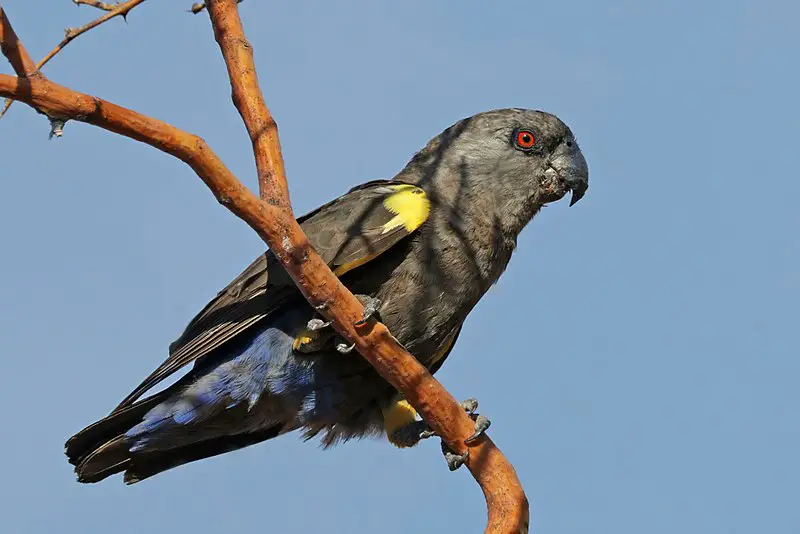
Rüppell’s parrot is a beautiful bird native to southwestern Africa. It has vibrant green and yellow feathers, with a distinct blue patch on its head, making it easily identifiable in the wild.
This species lives in savanna areas where there are trees or dry woodlands near streams and rivers.
The name of this bird honors German naturalist Eduard Rüppell for his contributions to science.
On average, an adult measures 22–25 cm (9 in) long and weighs 121–156 g. Its diet consists mainly of fruits from Acacia trees as well as seeds from grasses growing nearby water sources like lakes or dams – they also eat insects occasionally during their breeding season when food is scarce.
These birds typically live up to 10-15 years if kept healthy; however, some can reach 20 years old under the right conditions.Scientific classification:
| Kingdom | Animalia |
| Phylum | Chordata |
| Class | Aves |
| Order | Psittaciformes |
| Family | Psittacidae |
| Genus | Poicephalus |
| Species | P. rueppellii |
2. Bare-Cheeked Babbler
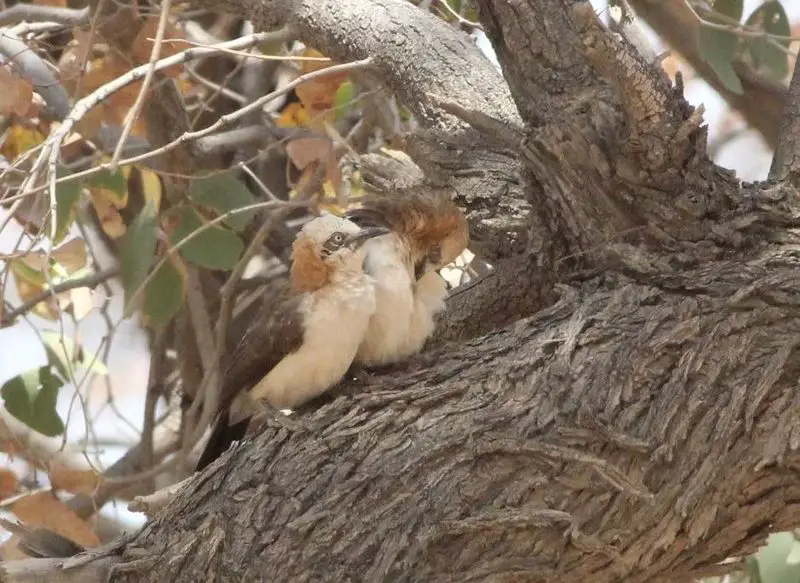
The Bare-cheeked babbler is a species of bird that can be found in Angola and Namibia. It has greyish or olive-brown plumage with white on its wings, throat, and cheeks; hence the name “Bare-cheeked”.
This bird prefers to live in dry forest areas or shrubland habitats where it will feed mainly on insects, but also some fruits and seeds if available.
Due to their large home range these birds are often seen alone rather than in flocks like many other birds.
They have been known to travel up to 27km per day foraging for food which makes them quite an active species.
Sadly this beautiful bird is listed as Near Threatened due mostly from habitat loss due human activities such as agriculture expansion and livestock grazing reducing the amount of suitable environments available for them.Scientific classification:
| Kingdom | Animalia |
| Phylum | Chordata |
| Class | Aves |
| Order | Passeriformes |
| Family | Leiothrichidae |
| Genus | Turdoides |
| Species | T. gymnogenys |
Also Featured In: Birds of Etosha National Park,
3. Monteiro’s Hornbill
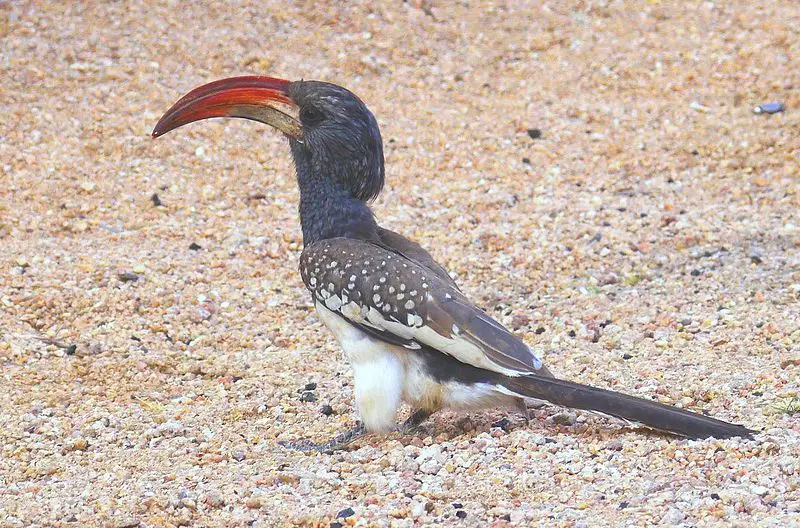
Monteiro’s hornbill is a species of large, striking bird that inhabits the dry woodlands of southwestern Africa.
It has an impressive length of 54-58 cm and weighs between 210 – 400g, making it one of the biggest members in its family.
This near-endemic species can be found predominantly in Namibia where their population stands at around 340,000 individuals.
They have a blackish body with white eyespots on each side; males also feature an orange throat patch which females lack.
With their iconic curved bill and loud call they are easily recognisable yet remain elusive to most people due to their remote habitats away from civilisation.Scientific classification:
| Kingdom | Animalia |
| Phylum | Chordata |
| Class | Aves |
| Order | Bucerotiformes |
| Family | Bucerotidae |
| Genus | Tockus |
| Species | T. monteiri |
4. Gray’s Lark
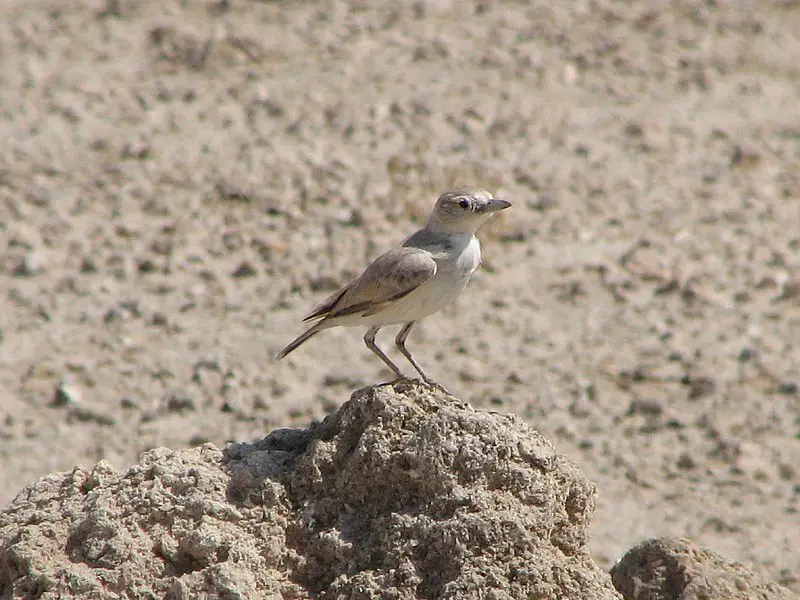
Gray’s lark is a species of lark found in south-western Africa. It inhabits hot deserts and has been reclassified in 2009 by the IOC into its own genus, Ammomanopsis.
This small bird has brown upperparts with whitish underparts which are heavily streaked below.
Its face is sandy gray with black streaks and it has a distinctive white eyebrow stripe above the eyes.
The long tail feathers have faint buff fringes to them while both sexes possess an orange patch on their wings during breeding season as part of their courtship displays.
Gray’s Larks feed mainly on seeds and insects, hopping between clumps of vegetation or along bare ground looking for food sources that can sustain them through the harsh desert climate they live in.Scientific classification:
| Kingdom | Animalia |
| Phylum | Chordata |
| Class | Aves |
| Order | Passeriformes |
| Family | Alaudidae |
| Genus | Ammomanopsis Bianchi, 1905 |
| Species | A. grayi |
5. Hartlaub’s Spurfowl
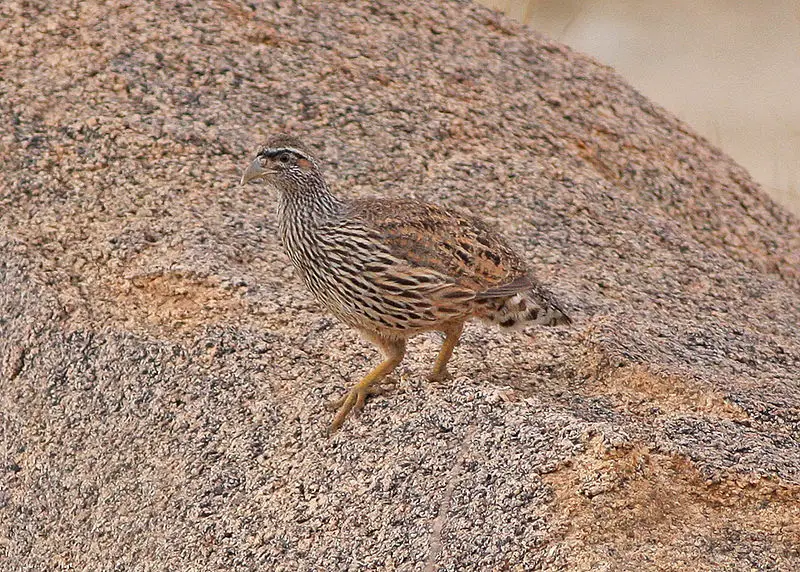
Hartlaub’s spurfowl is a species of bird belonging to the pheasant family Phasianidae. It is endemic to Namibia and Angola, found in the escarpment zone there.
This beautiful creature was first described by Portuguese naturalist José Vicente Barbosa du Bocage in 1869, who named it after German physician and ornithologist Gustav Hartlaub as an honourary gesture.
The plumage of this medium-sized bird consists mainly of blackish brown coloration with white spots on its wings; its tail has faint barring pattern while its underside is paler than the rest body parts.
As far as behavior goes, they are usually seen foraging or roosting on trees during day time but become more active at night when searching for food like seeds, shoots etc., making them omnivorous feeders.Scientific classification:
| Kingdom | Animalia |
| Phylum | Chordata |
| Class | Aves |
| Order | Galliformes |
| Family | Phasianidae |
| Genus | Pternistis |
| Species | P. hartlaubi |
6. Benguela Long-Billed Lark
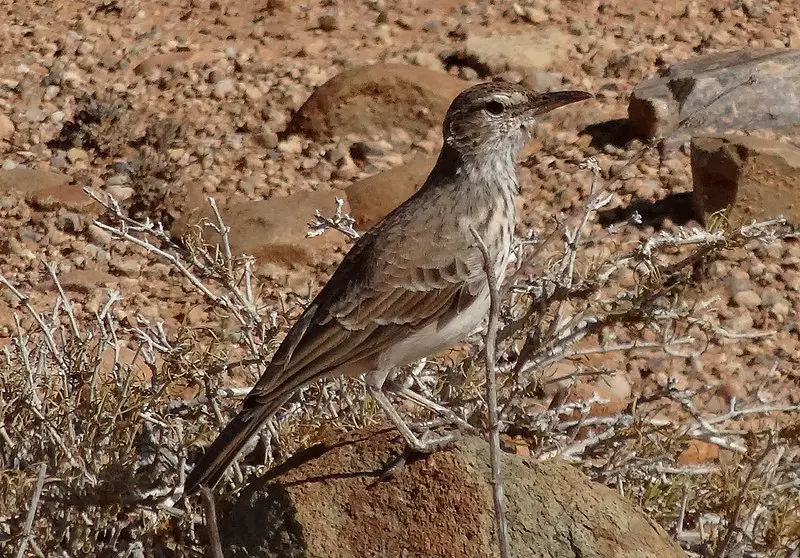
The Benguela long-billed lark is a species of bird found in south-western Africa. It has brown and buff plumage, with darker streaks on the back and wings.
Its bill is longer than most other larks’ giving it its name, while its tail feathers are white tipped.
They inhabit subtropical or tropical dry lowland grasslands usually near water sources such as rivers or streams.
The population size of this species is unknown but they appear to be quite common across their range so are not currently considered threatened by conservationists.
Despite being placed in the genus Alaemon when first described, recent research suggests that this species belongs more appropriately within Certhilauda due to morphological similarities between them both.Scientific classification:
| Kingdom | Animalia |
| Phylum | Chordata |
| Class | Aves |
| Order | Passeriformes |
| Family | Alaudidae |
| Genus | Certhilauda |
| Species | C. benguelensis |
7. Rüppell’s Korhaan
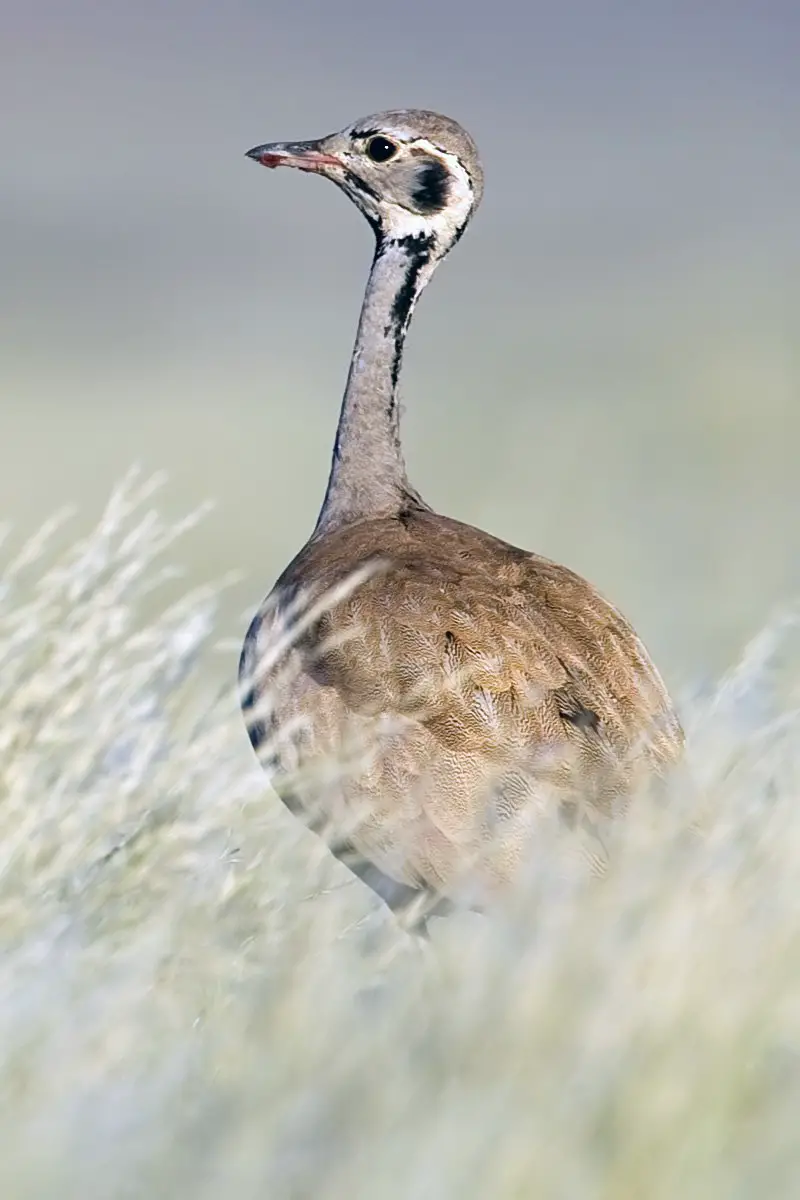
Rüppell’s Korhaan is a small bird belonging to the family Otididae. It measures about 60 cm in length and has a grey head and neck, with black stripes down its throat (fainter on females), through its eye and along the sides of its neck, as well as white cheeks.
The upper body is sandy brown while the underside is white. Its legs are yellow-sandy colored.
This species lives mainly in arid areas of eastern Africa, from Ethiopia southwards to Namibia but also occurs locally on other parts of Sub Saharan African savanna grasslands where it feeds primarily on insects such as ants and termites by using their long beaks for probing into crevices or digging up soil mounds beneath which they find prey items.Scientific classification:
| Kingdom | Animalia |
| Phylum | Chordata |
| Class | Aves |
| Order | Otidiformes |
| Family | Otididae |
| Genus | Eupodotis |
| Species | E. rueppellii |
8. Cardinal Woodpecker
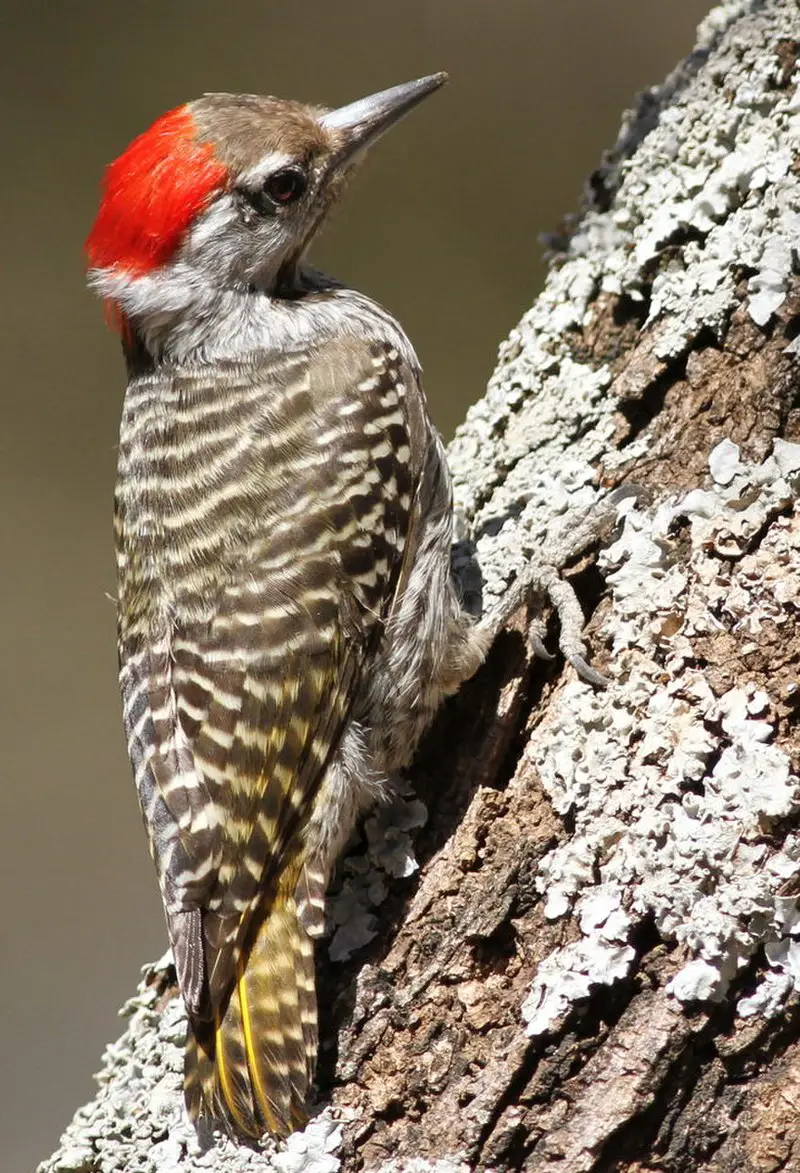
The Cardinal Woodpecker is a widespread and common resident found in much of sub-Saharan Africa. It inhabits various habitats, from dense forests to thorny bushlands, making it quite adaptable.
This species can be identified by its distinctive call notes as well as the difference between males and females which are distinguishable through their head patterns.
The bird was first described in 1818 by French ornithologist Louis Pierre Vieillot who recognized this unique species among other woodpeckers that inhabit the same region.
Despite being so widely spread throughout Africa, little is known about its behavior or population size due to lack of research on the subject – something that should surely change going forward.Scientific classification:
| Kingdom | Animalia |
| Phylum | Chordata |
| Class | Aves |
| Order | Piciformes |
| Family | Picidae |
| Genus | Dendropicos |
| Species | D. fuscescens |
9. Golden-Tailed Woodpecker
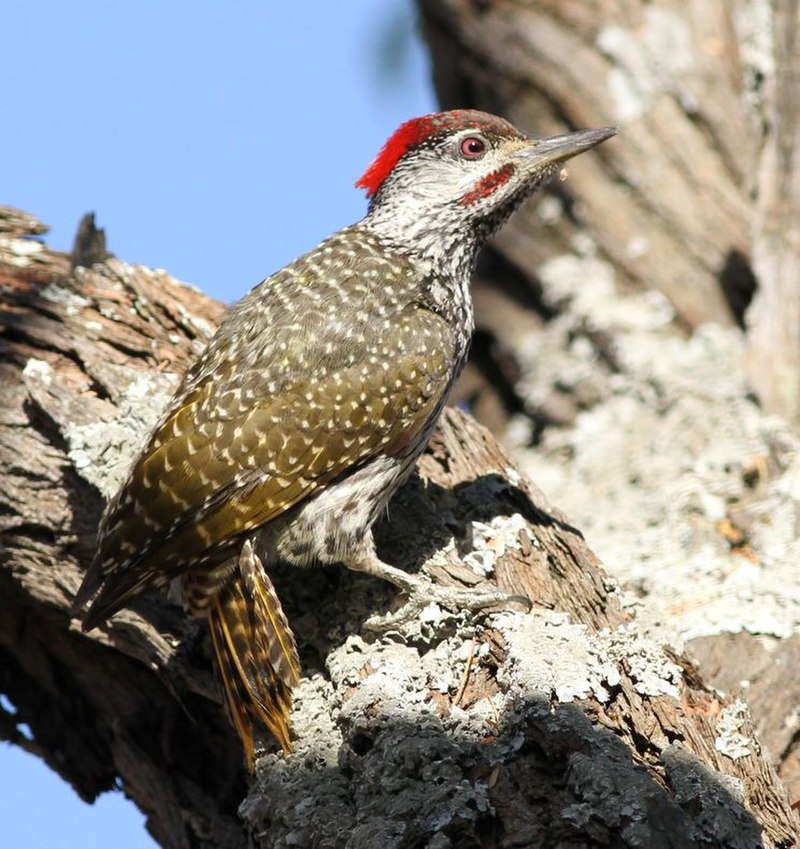
The golden-tailed woodpecker is a beautiful species of bird belonging to the Picidae family. It is named after the 5th Earl of Abingdon and has a gorgeous combination of barred, greenish upper parts.
This species can be found in central Africa from southern Sudan to northern Angola and Zambia. Its range also extends southwards through eastern Democratic Republic of Congo into Uganda, Kenya and Tanzania.
Golden-tailed woodpeckers are usually solitary birds which feed on insects by hammering at tree bark with their strong bills for food such as larvae or pupae that live under the bark surface.
They may also eat fruit when it’s available seasonally but will rarely congregate together except during breeding seasons when they pair off for nesting purposes in cavities excavated from trees like other members of its family do too.Scientific classification:
| Kingdom | Animalia |
| Phylum | Chordata |
| Class | Aves |
| Order | Piciformes |
| Family | Picidae |
| Genus | Campethera |
| Species | C. abingoni |
10. Kori Bustard
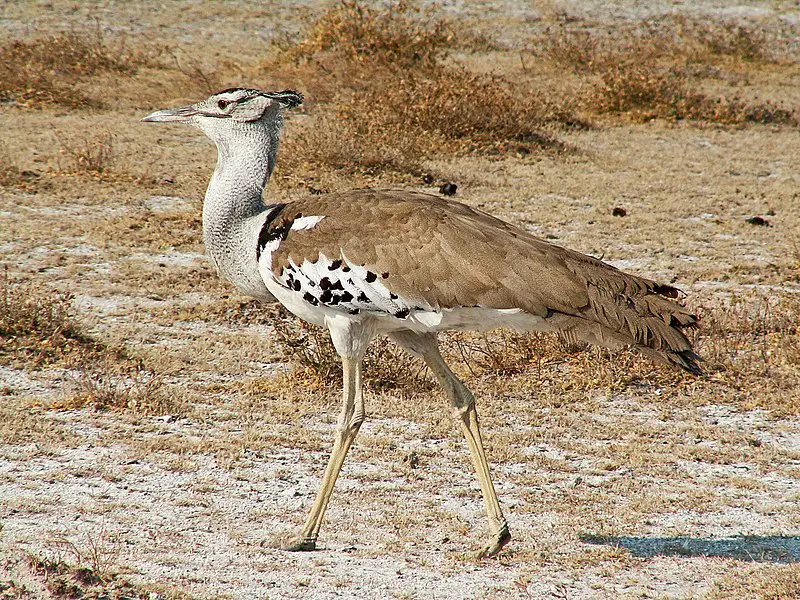
The Kori Bustard is the largest flying bird native to Africa and part of the bustard family. It has a large body, with males reaching up to 20kg in weight – making it one of the heaviest living animals capable of flight.
Its range covers most African countries from Ethiopia all the way down south towards South Africa.
The Kori Bustard is omnivorous and feeds on insects, small lizards, seeds, fruit and even carrion if available.
Their feathers are mostly brownish grey while their heads have black stripes running over them which makes them easily identifiable when seen in its natural habitat.
They usually live alone or in pairs during breeding season but will gather into larger groups at other times throughout their lives; typically nesting on dry open grasslands near water sources for easy access to food and drink.Scientific classification:
| Kingdom | Animalia |
| Phylum | Chordata |
| Class | Aves |
| Order | Otidiformes |
| Family | Otididae |
| Genus | Ardeotis |
| Species | A. kori |
11. Red-Chested Cuckoo
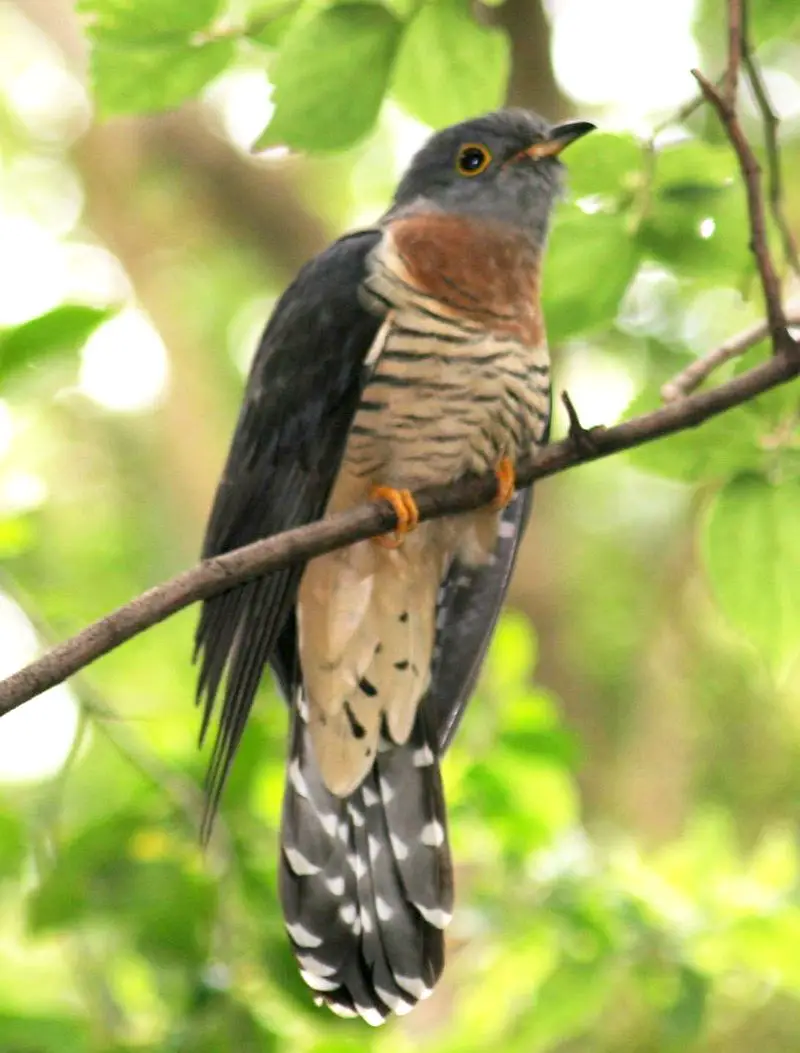
The red-chested cuckoo is a medium size bird, measuring at around 31 cm. It has slate grey upper parts and pale grey throat and sides of head.
The tail has dark grey tip with white spots on it that provide an extra decorative feature to the already beautiful bird.
Its call in Afrikaans is ‘Piet-my-vrou’, which adds to its charm as one can easily relate this wonderful sound to the majestic creature itself.
Inhabiting Africa south of the Sahara, these birds are generally found near woodlands areas or tropical rainforests where they feed upon insects such as caterpillars, grasshoppers and wild fruits like berries for sustenance.
Their nesting habits involve laying eggs in other species’ nests usually after having eaten up some of their host’s eggs first. This unique behavior makes them fascinating creatures indeed.Scientific classification:
| Kingdom | Animalia |
| Phylum | Chordata |
| Class | Aves |
| Order | Cuculiformes |
| Family | Cuculidae |
| Genus | Cuculus |
| Species | C. solitarius |
12. Violet Wood Hoopoe
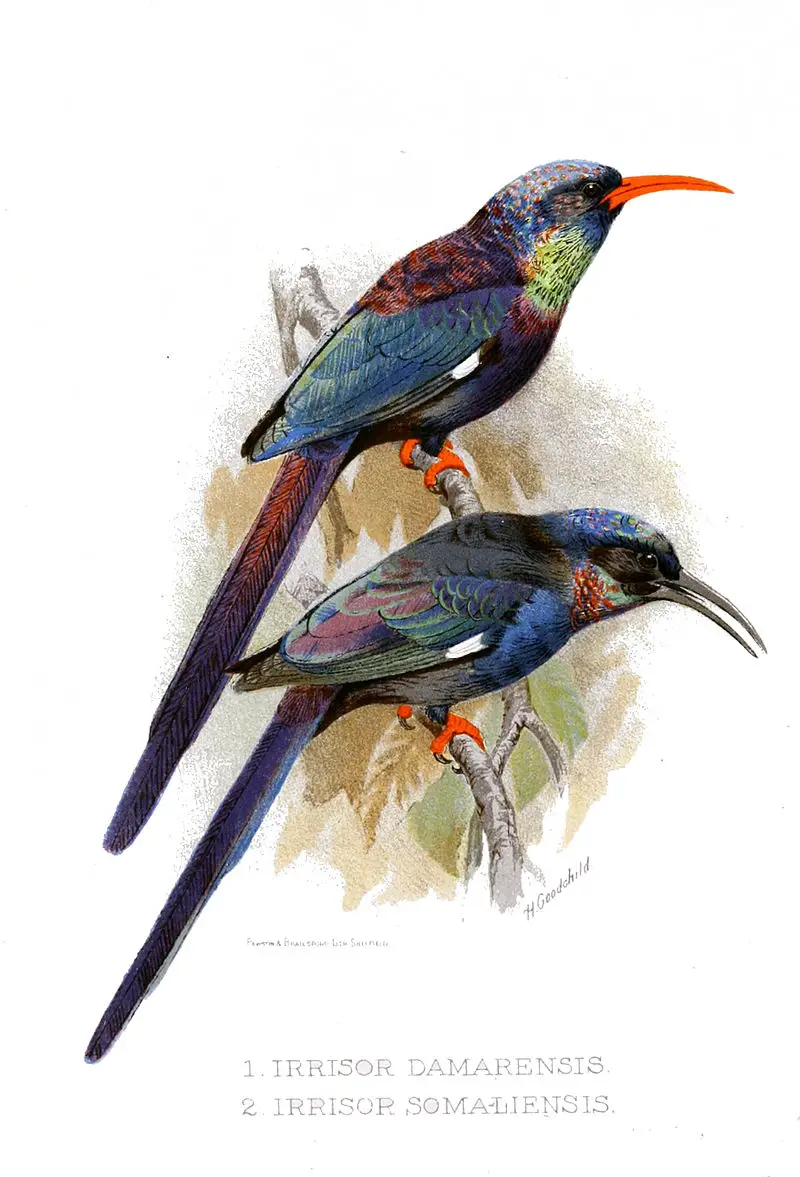
The Violet wood hoopoe is a large, colorful bird found in Angola, Kenya, Namibia and Tanzania. It has an unmistakable plumage of violet-blue feathers on its wings and tail with black markings along the edges.
Its head is adorned with a red beak and green throat patch that stands out against its otherwise dark body. It also sports striking white stripes around each eye for added contrast.
Grant’s wood hoopoe (P. d granti) may sometimes be considered as a distinct species due to slight differences in their appearance such as bill coloration or patterning variations on the neck region; however more research needs to be done before confirming this status change officially.
The diet of these birds consists mainly of insects which they find by probing into tree bark or soil crevices while searching for food sources during flight or while perched atop branches high up in trees.Scientific classification:
| Kingdom | Animalia |
| Phylum | Chordata |
| Class | Aves |
| Order | Bucerotiformes |
| Family | Phoeniculidae |
| Genus | Phoeniculus |
| Species | P. damarensis |
13. Northern Black Korhaan
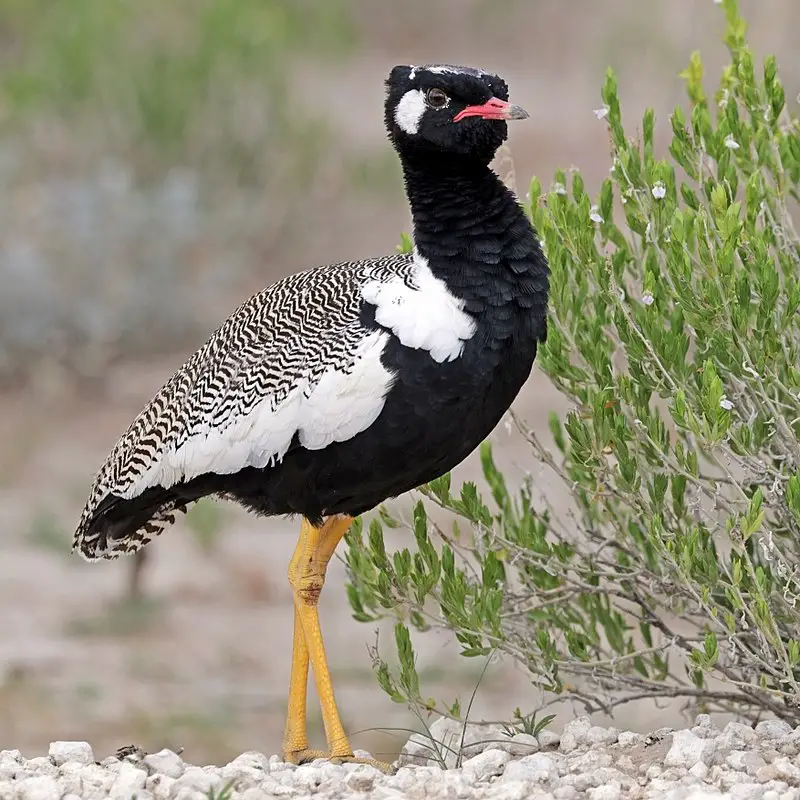
The Northern Black Korhaan, or White-Quilled Bustard, is an impressive bird found across Southern Africa. This species of bustard is highly adapted to open grasslands and scrubland habitats.
It was first discovered by Andrew Smith in 1831 and given the scientific name “afrao”.
The appearance of these birds can vary greatly depending on where they are located; some feature a distinctive white head plume while others have black feathers that cover their whole bodies.
They also tend to be quite large with wingspans reaching up to 42 inches long. These majestic creatures play important roles in their ecosystems as both predators and prey for other animals.
Despite all this beauty, sadly populations have been declining due to human activities such as habitat destruction and hunting pressure from poachers.
With conservation efforts we hope that the future looks brighter for these amazing birds.Scientific classification:
| Kingdom | Animalia |
| Phylum | Chordata |
| Class | Aves |
| Order | Otidiformes |
| Family | Otididae |
| Genus | Afrotis |
| Species | A. afraoides |
14. Shorebirds
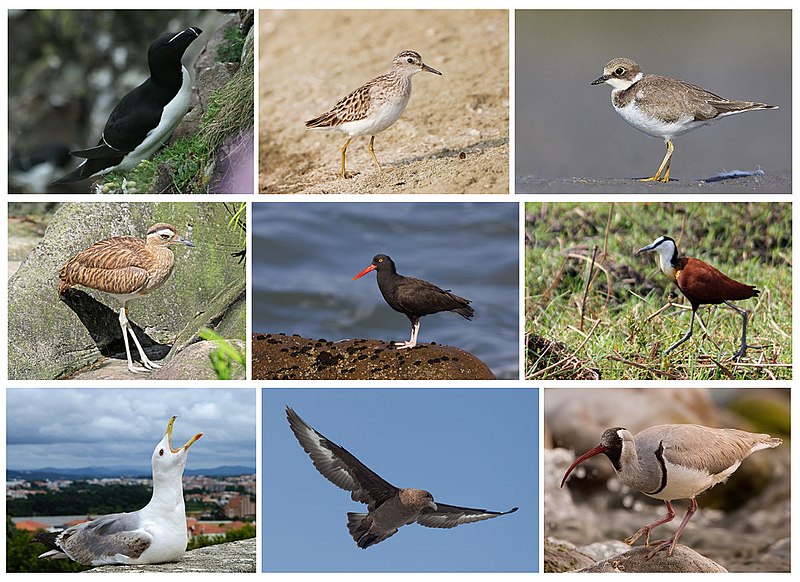
Shorebirds, a diverse group of birds in the Charadriiformes order, are found near water on every continent except Antarctica.
These small to medium-sized birds feed mainly on invertebrates and other small animals but can also be pelagic seabirds or inhabit deserts.
Shorebirds use their long bills to probe mudflats for food like worms and mollusks while some species plunge into the ocean’s depths in search of crustaceans such as crabs and shrimp.
They have strong legs equipped with webbed feet which allow them to move quickly when searching for prey across wetlands, sandbars, beaches and swamps.
Their feathers make them well adapted to life by land or sea due to its hydrophobic nature which helps reduce drag during swimming or flying through windy conditions making it easier for shorebirds survive tough environments around the world.Scientific classification:
| Kingdom | Animalia |
| Phylum | Chordata |
| Class | Aves |
| Infraclass | Neognathae |
| Clade | Neoaves |
| Clade | Gruimorphae |
| Order | Charadriiformes Huxley, 1867 |
15. Mousebird
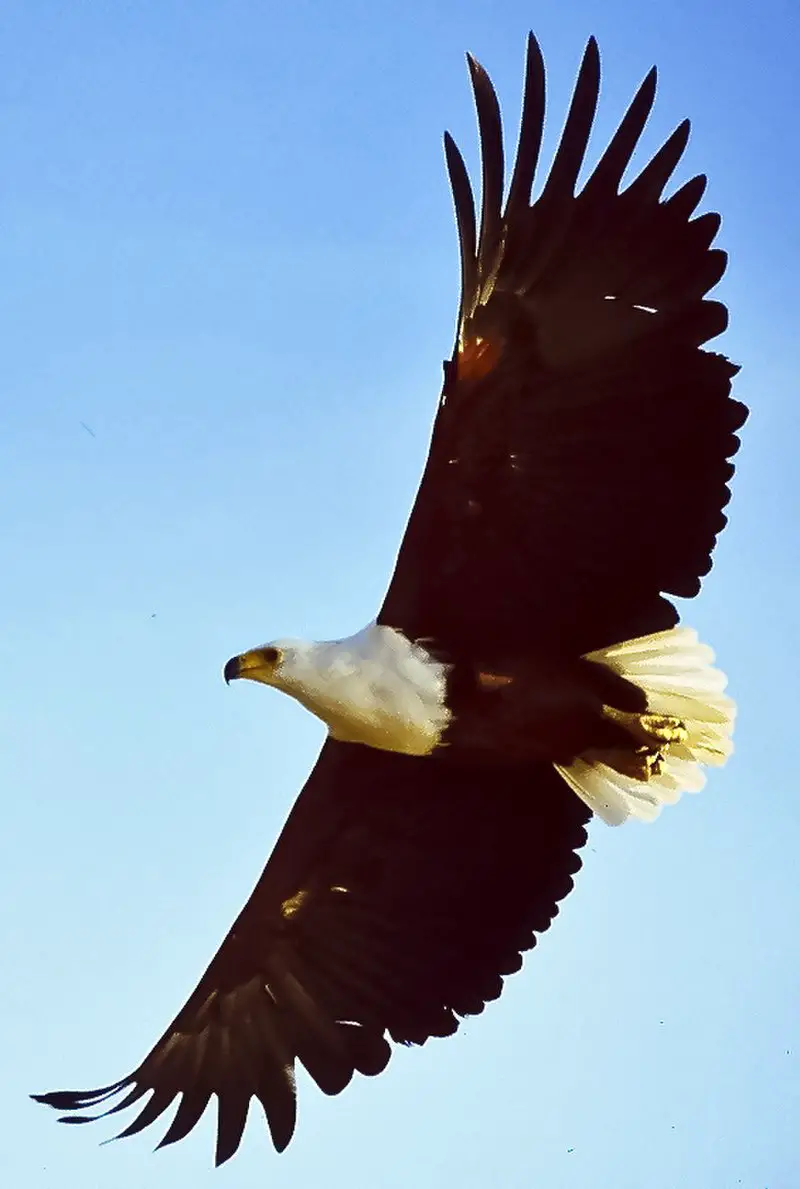
Mousebirds are a small group of birds that belong to the Coliiformes family. They have long tails with rounded wings and short legs, making them look like tiny mice when they fly.
Mousebirds range in color from grays and browns to blues and greens, depending on the species. Their diet consists mainly of fruit, flowers, buds and seeds but can also include insects such as ants or beetles.
They live in open woodlands throughout Africa where their slim bodies make it easy for them to squeeze through tight spaces between branches or into crevices among rocks looking for food.
Their inquisitive nature makes these birds fun to watch as they move swiftly around searching for something tasty.
Both males and females raise young together in colonies which is an interesting behavior uncommon among other bird species.
Overall mousebird’s unique looks combined with its active lifestyle make it an intriguing creature often seen darting about in African forests
16. Little Bee-Eater
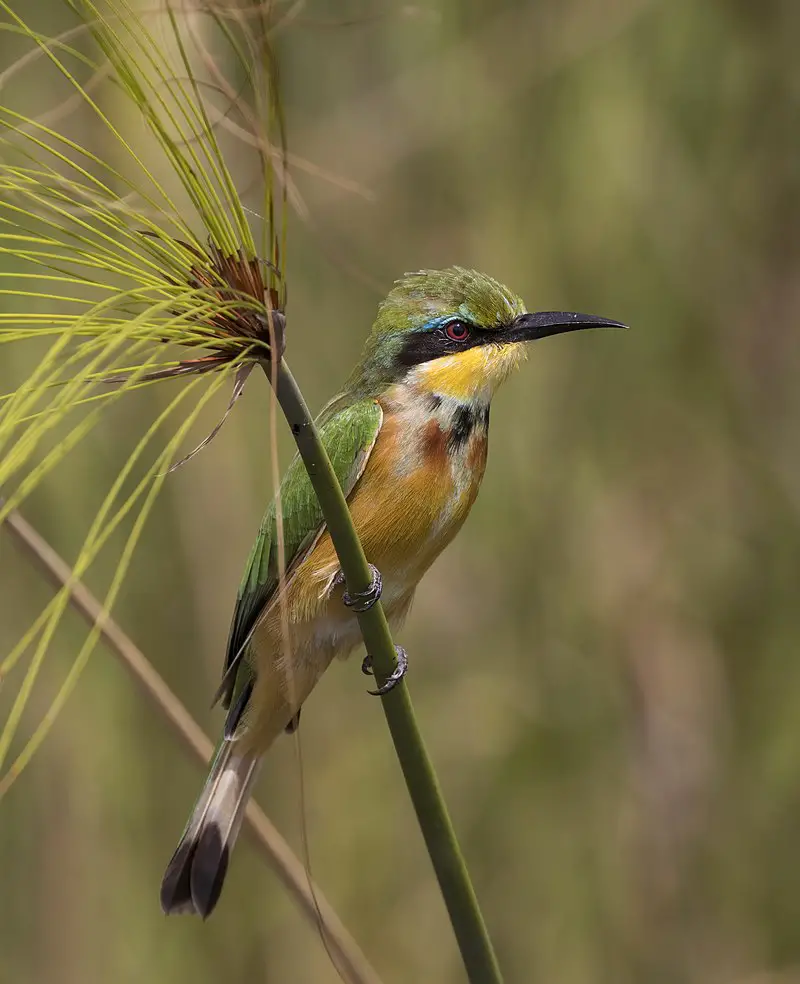
The Little Bee-eater (Merops pusillus) is a beautiful species of bird belonging to the family Meropidae.
These birds are found in much of Sub-Saharan Africa and their migration patterns depend on seasonal rainfall changes.
They have slender, brightly coloured bodies with an iridescent green sheen across the wings and back.
Their diet consists mainly of bees, wasps, dragonflies, moths and other insects which they catch mid-air or from perches above open grasslands or along mudbanks near water sources like rivers and lakes.
In order for these birds to digest their food properly before swallowing it whole, they use pebbles that help them grind up hard exoskeletons so as not to cause any blockages within their digestive tract – something only bee-eaters do.Scientific classification:
| Kingdom | Animalia |
| Phylum | Chordata |
| Class | Aves |
| Order | Coraciiformes |
| Family | Meropidae |
| Genus | Merops |
| Species | M. pusillus |
17. African Cuckoo

The African cuckoo is an easily recognizable species of bird belonging to the Cuculidae family. With its distinct plumage and call, it can be found in Sub-Saharan Africa, where it migrates seasonally.
During the rainy season they arrive in their breeding grounds ready to lay eggs in other birds’ nests as part of their nesting habits.
They are fairly common across much of Africa and have a conservation status rated as ‘least concern’ by the International Union for Conservation of Nature (IUCN).
The African cuckoo is medium sized with long tail feathers which provide them with excellent maneuverability while flying or perching on trees.
Its diet consists mainly insects such as caterpillars and dragonflies but sometimes also includes fruits or small reptiles if available.Scientific classification:
| Kingdom | Animalia |
| Phylum | Chordata |
| Class | Aves |
| Order | Cuculiformes |
| Family | Cuculidae |
| Genus | Cuculus |
| Species | C. gularis |
18. Bennett’s Woodpecker
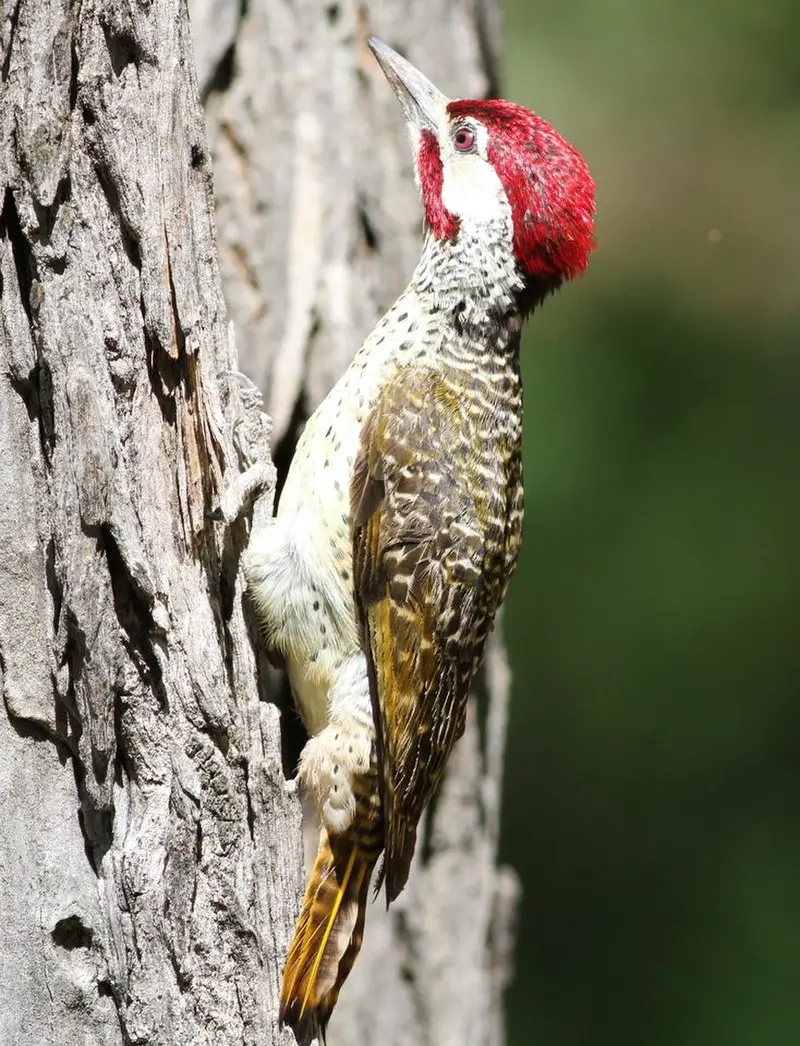
Bennett’s woodpecker is a species of bird belonging to the family Picidae. It has been found in African woods and bushes, classified as least-concern by IUCN due to its widespread range.
Named after Andrew Smith who described it in 1836, two subspecies have been identified – Campethera bennettii bennettii and C.b capricorni.
This small yet attractive bird has black wings with white spots on them while their chest and abdomen are predominantly brownish red or yellowish depending upon the region they inhabit.
They feed mainly on insects like ants, beetles etc which makes them important for insect control too.
Bennett’s woodpeckers play an essential role in maintaining balance within their ecosystem through nesting holes that provide shelter for other animals such as bats, owls etc., making these birds vital part of any forest environment.Scientific classification:
| Kingdom | Animalia |
| Phylum | Chordata |
| Class | Aves |
| Order | Piciformes |
| Family | Picidae |
| Genus | Campethera |
| Species | C. bennettii |
19. Black-Collared Barbet
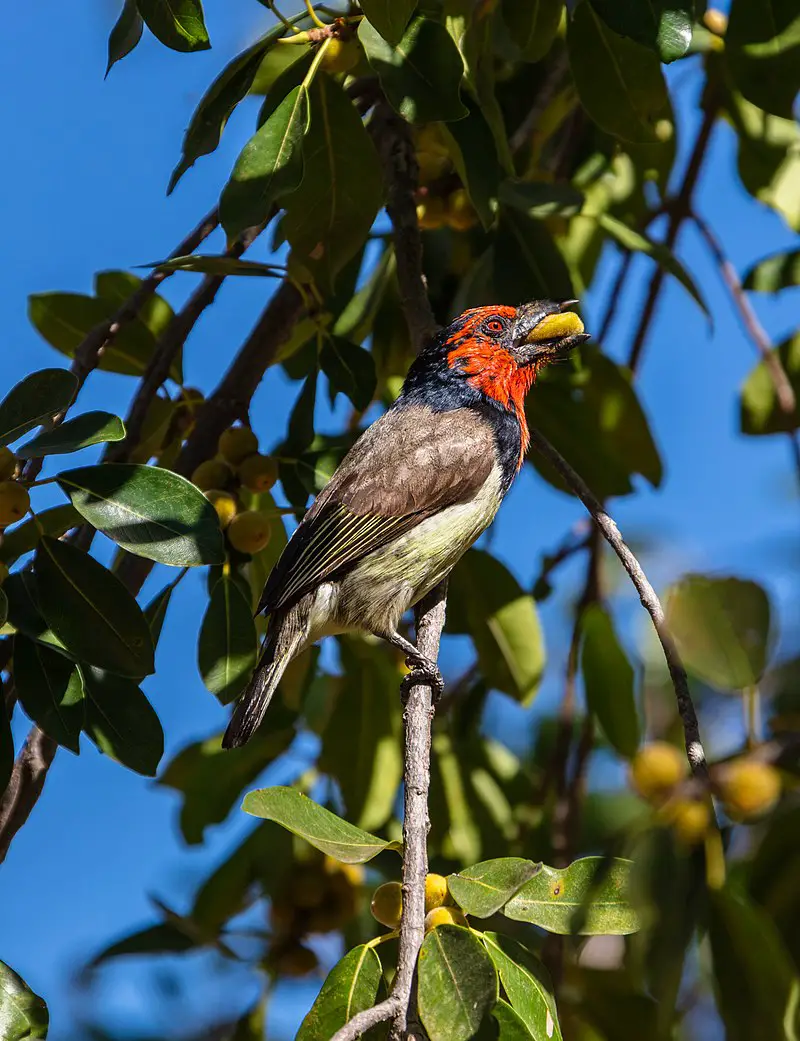
The Black-collared barbet is a species of bird found in sub-Saharan Africa. Indigenous peoples have various names for this brightly coloured creature, such as Rooikophoutkapper in Afrikaans, IsiKhulukhulu and IsiQonQotho in Zulu, and Isinagogo in Xhosa.
It can be seen across Angola, Botswana, Burundi, Democratic Republic of the Congo (DRC), Eswatini (formerly Swaziland), Kenya, Lesotho Malawi and Mozambique.
This medium sized bird has mainly black feathers with white speckles on its wings. The most distinctive feature is its bright yellow collar around its neck which gives it an attractive appearance.
These birds are often observed feeding on fruits or insects from trees or shrubs making them entertaining to watch for any wildlife enthusiast.Scientific classification:
| Kingdom | Animalia |
| Phylum | Chordata |
| Class | Aves |
| Order | Piciformes |
| Family | Lybiidae |
| Genus | Lybius |
| Species | L. torquatus |
20. Carp’s Tit
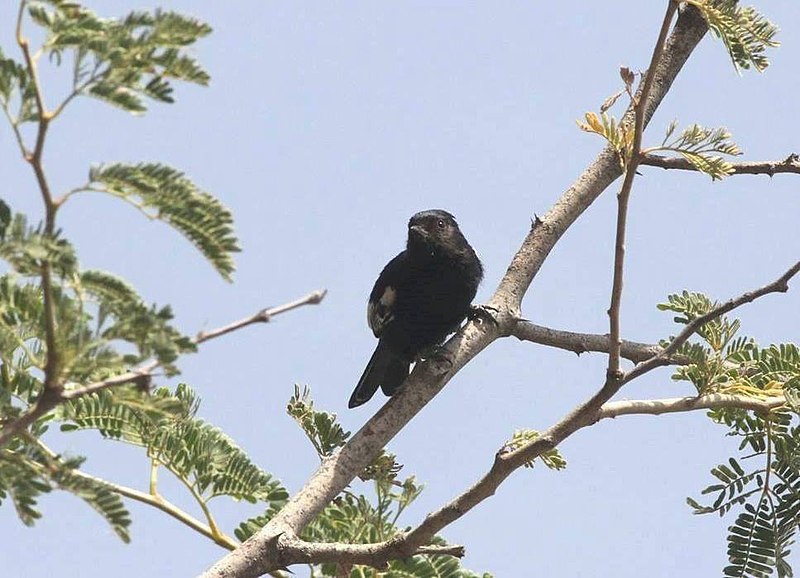
Carp’s tit is a species of bird found in the Namibian and southern Angolan savanna woodlands. It is also known as Carp’s black tit, or sometimes considered to be a subspecies of the black tit.
This species was named after olympic sailor and ornithologist Berend Carp (1901-1966). The Carp’s Tit belongs to the family Paridae, which used to include many other species within its genus Parus.
These birds are usually quite small with brownish gray feathers on their heads, back, wings and tails; they have white bellies with some yellow patches around them too.
They mainly feed on insects but will take advantage of any food source available such as seeds or fruits when necessary.
All in all these birds make for an interesting sight while living in their habitat – so keep your eyes peeled if you’re ever out there.Scientific classification:
| Kingdom | Animalia |
| Phylum | Chordata |
| Class | Aves |
| Order | Passeriformes |
| Family | Paridae |
| Genus | Melaniparus |
| Species | M. carpi |
21. Lesser Honeyguide
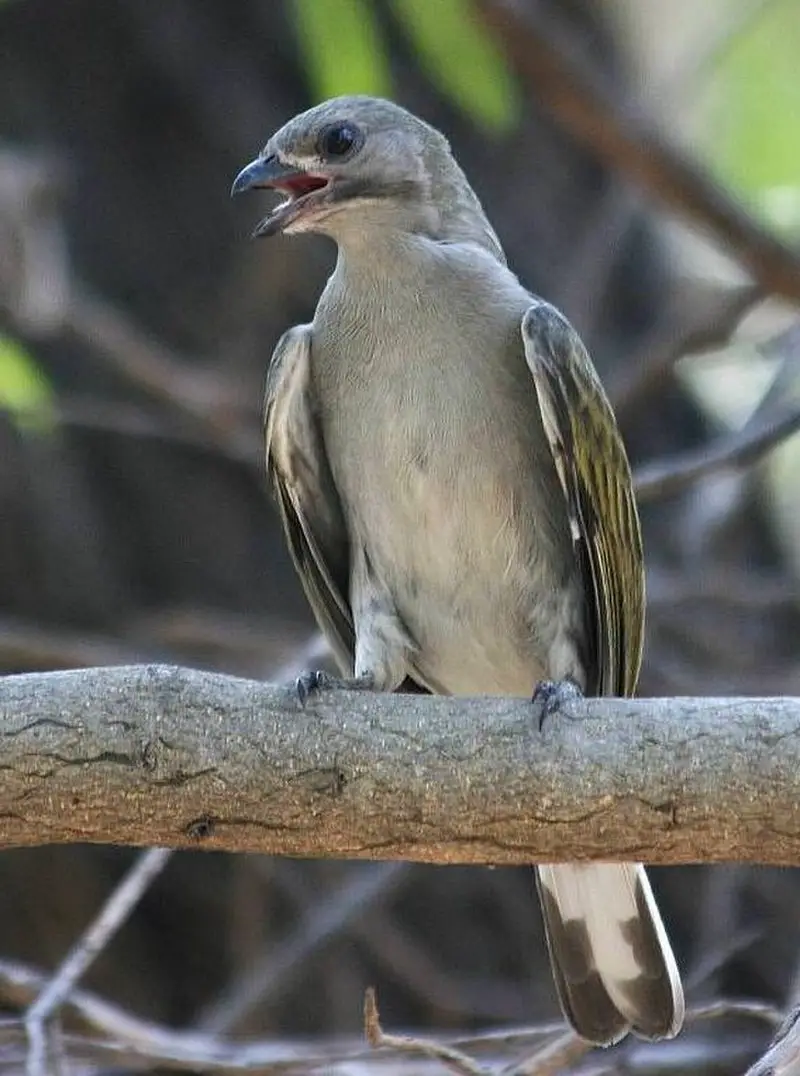
The lesser honeyguide is a species of bird found across Central and Sub-Saharan Africa. It is part of the Indicatoridae family, which are known for their ability to locate bees nests by listening to their buzzing sound from far away.
The birds then use this knowledge to guide humans or other animals towards the nest so that they can eat its contents – usually wax and honeycomb.
They will then feed on any remaining morsels themselves. These birds have greyish brown plumage with white patches below each eye and yellow beaks with black tips.
Their diet consists mainly of insects but also includes fruits, seeds, and nectar when available. So next time you’re out in nature remember: if you hear some buzzing nearby it could just be your own personal honeyguide.Scientific classification:
| Kingdom | Animalia |
| Phylum | Chordata |
| Class | Aves |
| Order | Piciformes |
| Family | Indicatoridae |
| Genus | Indicator |
| Species | I. minor |
22. African Skimmer
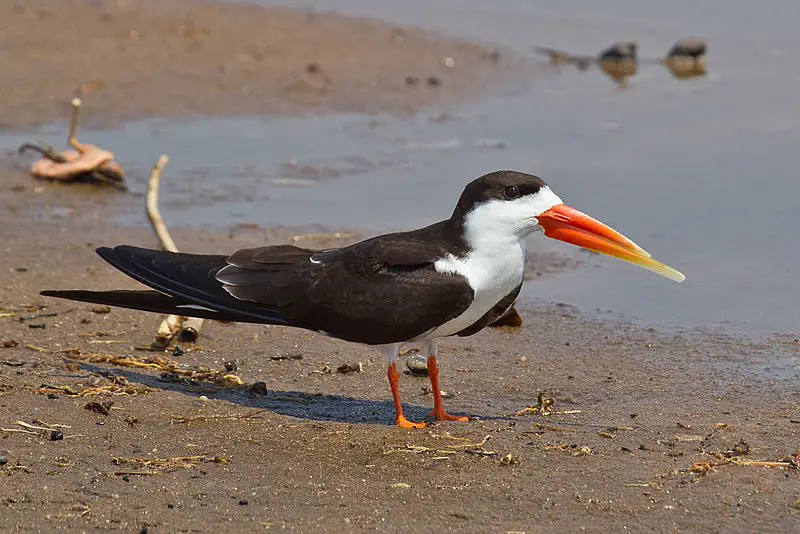
The African skimmer is a species of bird found in Sub-Saharan Africa along rivers, lakes and lagoons. It has long wings with a black back and crown.
The forehead and body are white, while the beak is bright orange but ending in yellow or black depending on its maturity level.
This fascinating creature feeds by skimming the surface of water for small fish which it eats whole head first.
Its feet have special adaptations to allow them to swim better rather than just walk on land like other birds do.
They form large colonies during breeding season usually near their food sources where they also lay eggs within shallow ground nests made out of mud, pebbles and grasses as well as line them with feathers from other birds.Scientific classification:
| Kingdom | Animalia |
| Phylum | Chordata |
| Class | Aves |
| Order | Charadriiformes |
| Family | Laridae |
| Genus | Rynchops |
| Species | R. flavirostris |
23. Cinderella Waxbill
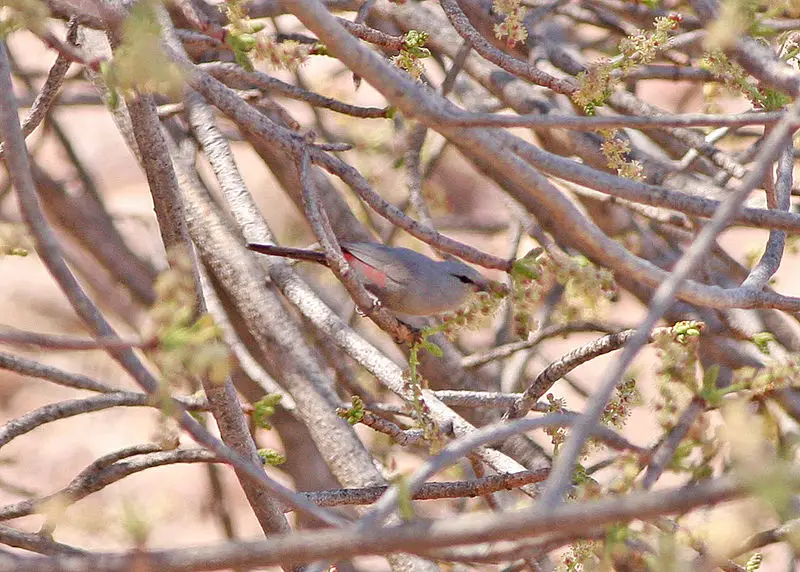
The Cinderella waxbill is a near-threatened species of estrildid finch found in the drier regions of south-western Angola and north-western Namibia. It has an estimated global distribution spanning 95,700 km2.
This beautiful bird lives mainly in subtropical and tropical areas where its natural habitat consists mostly of dry grasslands with sparse trees or shrubs for shelter during the hot days.
Its diet consists primarily of small seeds from plants as well as some insects when available.
The Cinderella waxbill is easily distinguishable by its unique combination of black wings, yellow face patch on top side back to head down to breast area, white belly and red upper tail feathers which it uses for courtship displays that show off their dazzling colours.
Unfortunately due to climate change this precious species may become more endangered so conservation efforts are needed now more than ever before if we want to preserve these birds for future generations.Scientific classification:
| Kingdom | Animalia |
| Phylum | Chordata |
| Class | Aves |
| Order | Passeriformes |
| Family | Estrildidae |
| Genus | Glaucestrilda |
| Species | G. thomensis |
24. Swallow-Tailed Bee-Eater
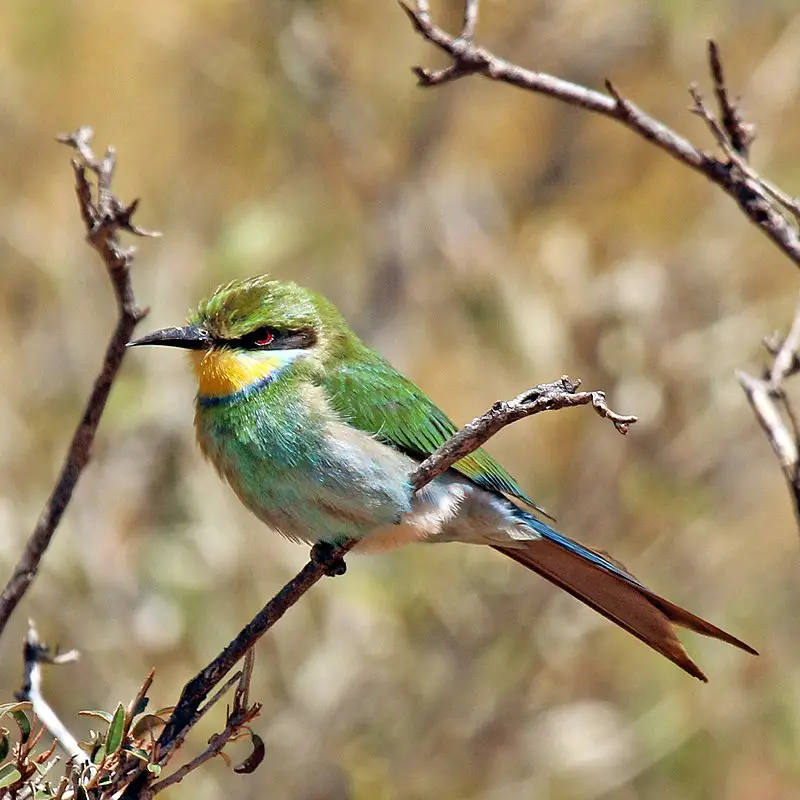
The Swallow-tailed bee-eater is a stunning bird, easily recognizable by its vibrant colours and forked tail. It has a green body with yellow throat, blue gorget and black eye stripe and beak.
Growing up to 20 – 22 cm in length from head to tail, these birds are quite slender.
They feed on insects such as bees, wasps or dragonflies that they catch in mid air before returning back to their perch where the prey is eaten.
These birds live in flocks of about 10 – 50 individuals which helps them protect against predators by forming an alert system amongst themselves when danger nears around them.
Being diurnal creatures, during night time they roost together over water streams or small trees making loud calls so as not to get lost while searching for each other come morning light.Scientific classification:
| Kingdom | Animalia |
| Phylum | Chordata |
| Class | Aves |
| Order | Coraciiformes |
| Family | Meropidae |
| Genus | Merops |
| Species | M. hirundineus |
25. Southern Carmine Bee-Eater
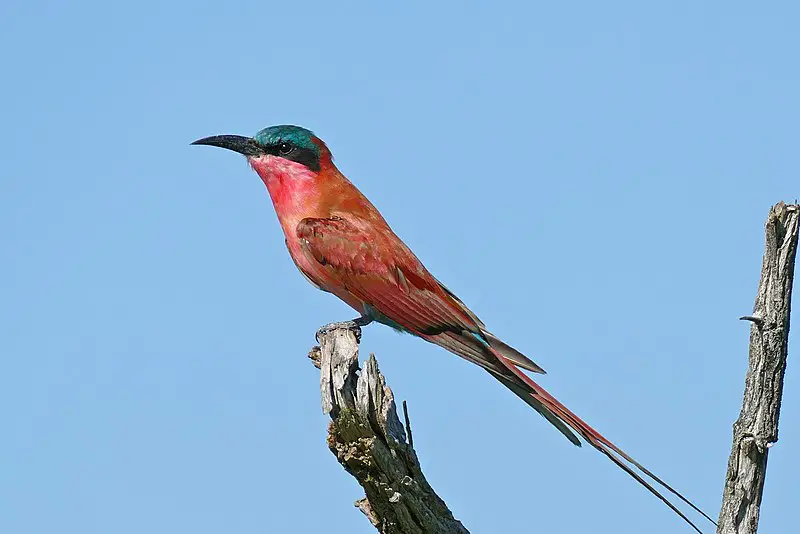
The Southern carmine bee-eater is a beautiful bird that can be found in subequatorial Africa. Its plumage is mainly carmine, but its crown and undertail are blue.
It ranges from KwaZulu-Natal and Namibia to Gabon, the eastern Democratic Republic of the Congo and Kenya.
This species feeds on insects like bees or wasps which it catches midair with acrobatic swoops while they’re flying by.
When not hunting for food these birds often gather together in large flocks before going off again to feed individually or as pairs.
They also roost communally at night near their regular feeding grounds so they can quickly return when dawn breaks.
The Southern carmine bee-eater plays an important role in controlling insect populations making them essential members of African ecosystems.Scientific classification:
| Kingdom | Animalia |
| Phylum | Chordata |
| Class | Aves |
| Order | Coraciiformes |
| Family | Meropidae |
| Genus | Merops |
| Species | M. nubicoides |
26. Senegal Coucal
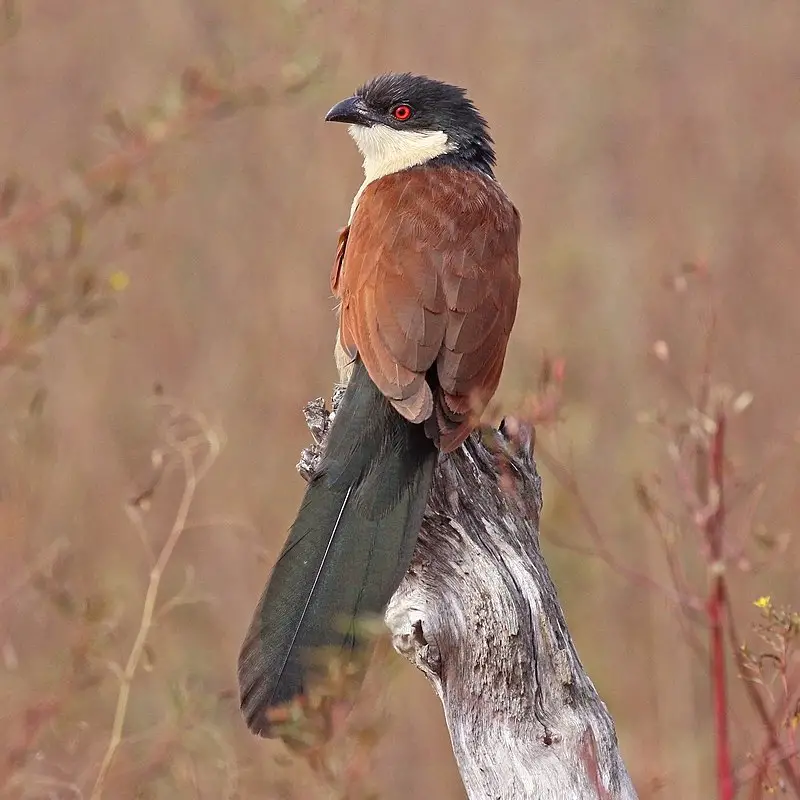
The Senegal coucal is a cuckoo-like bird native to Central and Southern Africa. It has a medium-sized body with black wings, tail and head along with white breast feathers.
Its natural habitat consists of lightly wooded savannahs where it feeds on insects, small reptiles, amphibians and fruits.
This species can be found in pairs or alone atop low bushes searching for prey or perched up high singing its distinctive song that features a mix of harsh notes as well as melodic ones.
The Senegal coucal enjoys the sun’s rays but also loves sheltering in dense vegetation when danger arises nearby.
Overall this beautiful bird makes an interesting addition to any backyard garden.Scientific classification:
| Kingdom | Animalia |
| Phylum | Chordata |
| Class | Aves |
| Order | Cuculiformes |
| Family | Cuculidae |
| Genus | Centropus |
| Species | C. senegalensis |
27. Pearl-Spotted Owlet
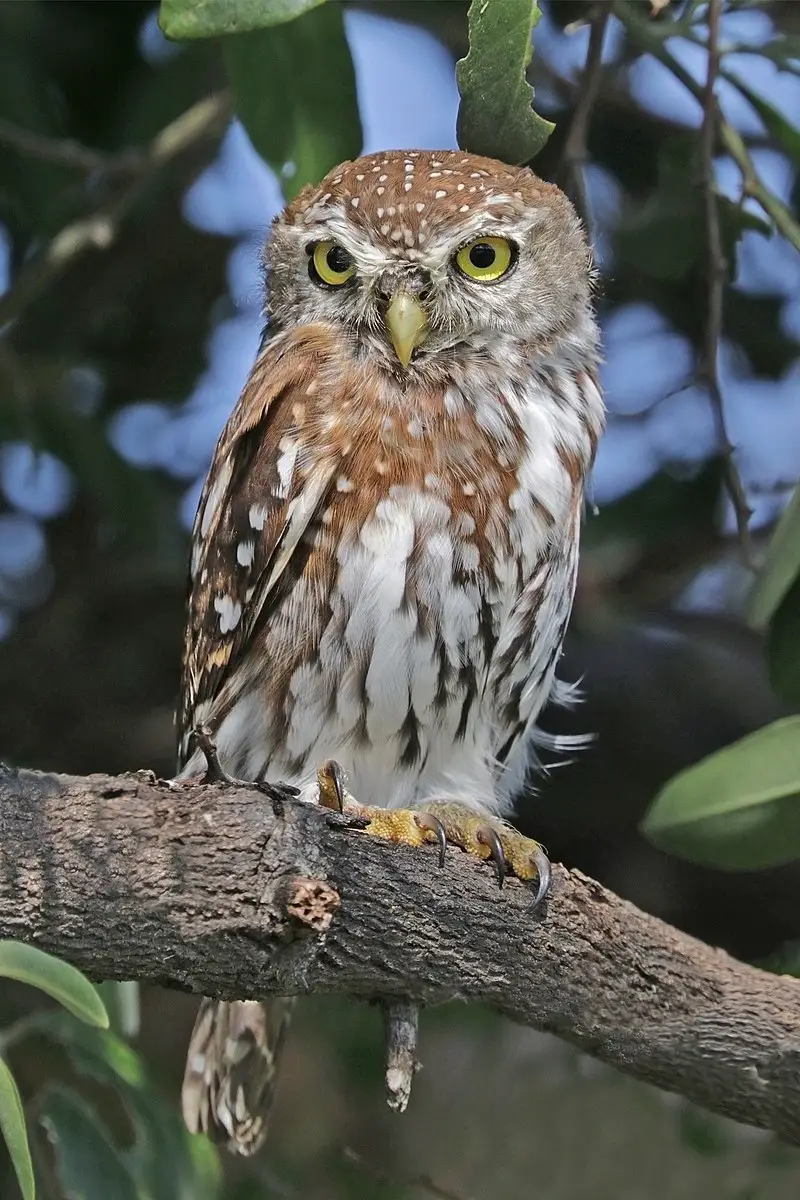
The Pearl-spotted Owlet is a small bird of prey that lives in sub-Saharan Africa. It belongs to the Strigidae family, which are commonly referred to as typical owls or true owls.
These birds have brown feathers with heavy spots, making them easily recognizable among other species of owl.
They usually measure between 14 and 16 centimeters long with an average wingspan of 28 centimeters wide.
Their diet consists mainly of insects such as moths and beetles but they also feed on frogs and small rodents occasionally.
During mating season males will use their sharp call for territorial purposes while females remain silent during this time period.
The female lays 2-4 eggs at one time before incubating them for around 3 weeks until hatching occurs after which both parents take part in feeding their young chicks until fledging age which is when they become independent enough to survive on their own in nature.Scientific classification:
| Kingdom | Animalia |
| Phylum | Chordata |
| Class | Aves |
| Order | Strigiformes |
| Family | Strigidae |
| Genus | Glaucidium |
| Species | G. perlatum |
28. Yellow-Fronted Tinkerbird
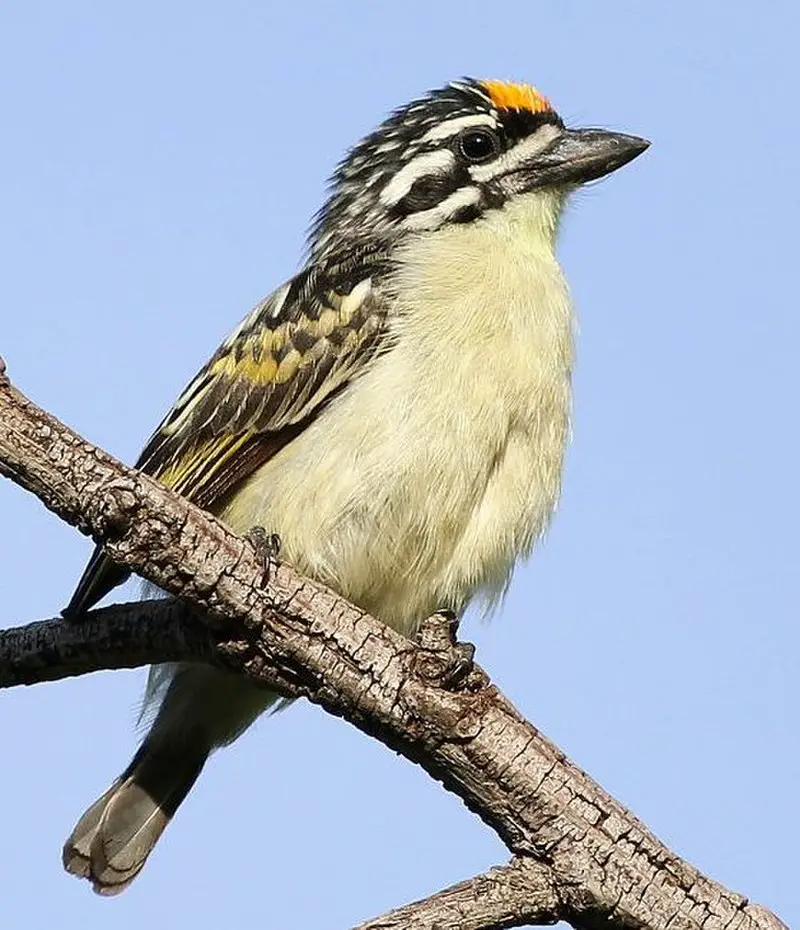
The yellow-fronted tinkerbird is a small African barbet found throughout tropical regions of the continent. It is easily recognized by its bright yellow forehead and brownish plumage, which may vary among different subspecies.
These birds feed mainly on insects and fruit; they use their stout bill to break open hard fruits while searching for food in dense vegetation.
They tend to live in pairs or family groups that occupy large territories, with males singing loudly from prominent perches during breeding season as part of territorial defense.
The population appears stable overall but some subspecies are considered threatened due to habitat destruction and fragmentation.Scientific classification:
| Kingdom | Animalia |
| Phylum | Chordata |
| Class | Aves |
| Order | Piciformes |
| Family | Lybiidae |
| Genus | Pogoniulus |
| Species | P. chrysoconus |
29. Coppery-Tailed Coucal
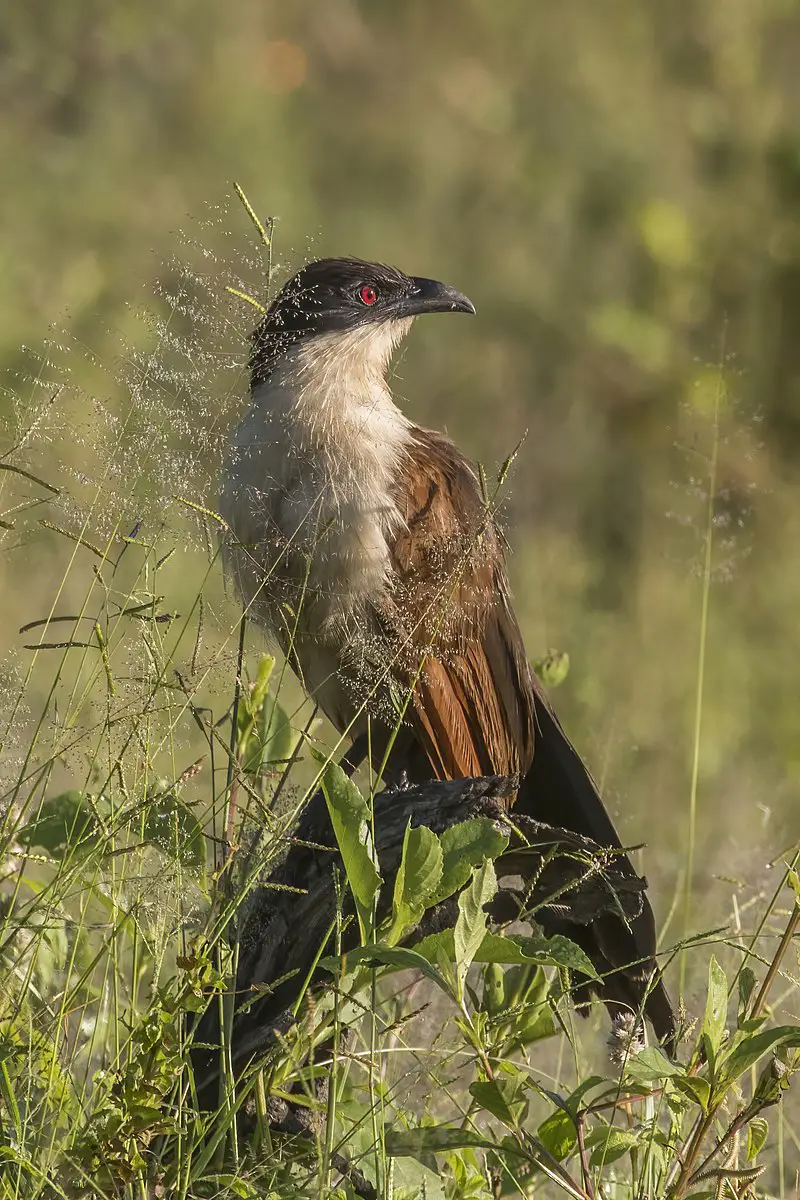
The Coppery-tailed coucal is a species of cuckoo found in African countries such as Angola, Botswana, the Democratic Republic of Congo, Malawi and Zimbabwe.
It was first described by German ornithologist Anton Reichenow in 1896. This bird has an adult body length of about 48 cm and its beak is curved while its tail is long and broad.
The plumage on their back ranges from olive green to copper brown with greyish white colouration on their underside feathers.
They have yellow eyes with black pupils which makes them quite distinctive along with red legs and feet that make it easier for them to move around quickly looking for food sources like insects or small reptiles.Scientific classification:
| Kingdom | Animalia |
| Phylum | Chordata |
| Class | Aves |
| Order | Cuculiformes |
| Family | Cuculidae |
| Genus | Centropus |
| Species | C. cupreicaudus |
30. Black Coucal
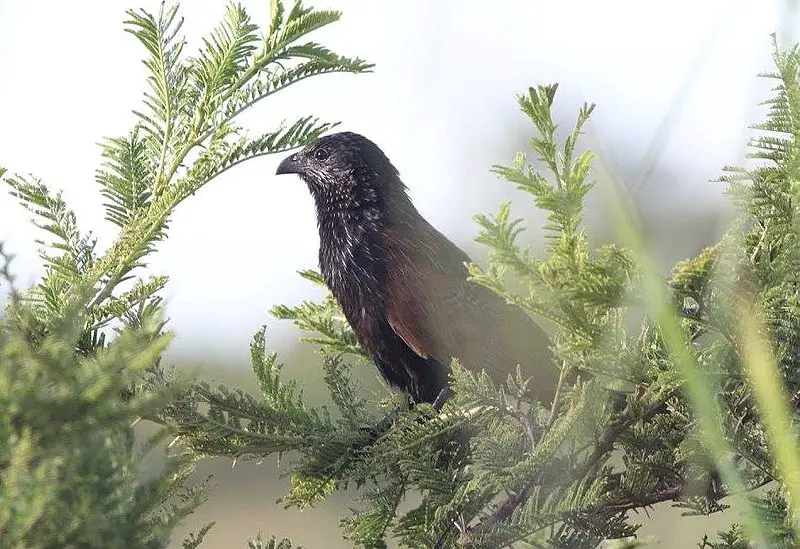
Black coucal is a species of cuckoo found in Africa south of the Sahara. Males are 30 cm long while females are 34 cm, both having similar appearance with black head and body along with buff barring on rump.
Wings have a reddish tinge to them making it easier to spot in its habitat. They breed during rains when food sources become abundant for their young ones.
Their diet consists mostly of insects like grasshoppers, beetles and caterpillars which they hunt from ground or trees depending on where their prey reside.
With such widespread distribution across Africa, this bird serves as an important part of the ecosystem by controlling insect population levels naturally thereby maintaining balance between various organisms living there.Scientific classification:
| Kingdom | Animalia |
| Phylum | Chordata |
| Class | Aves |
| Order | Cuculiformes |
| Family | Cuculidae |
| Genus | Centropus |
| Species | C. grillii |
31. White-Browed Coucal
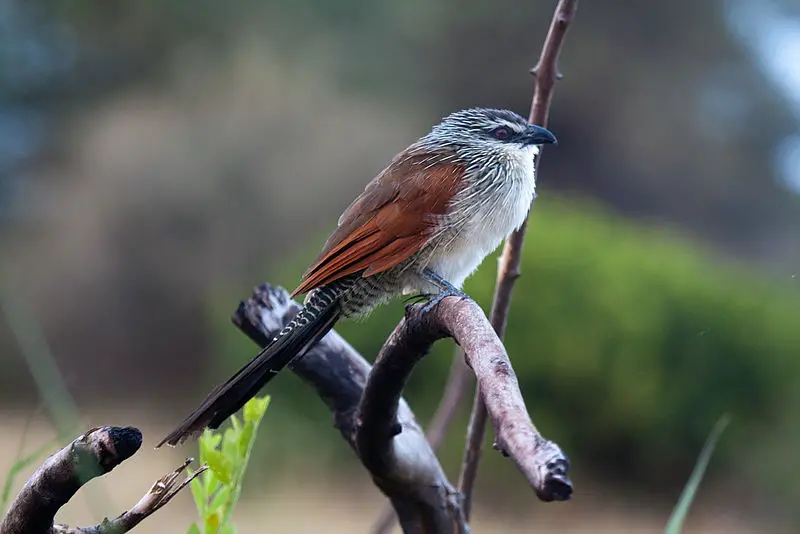
The White-browed Coucal is a species of bird belonging to the Cuculidae family. It can be found in sub-Saharan Africa, inhabiting thick vegetation and rank undergrowth as well as coastal regions.
This medium-sized cuckoo has a length between 36 and 42 cm and is sometimes considered a subspecies of Burchell’s coucal.
Its main distinguishing feature is its white eyebrow which extends towards the back of its head, giving it an elegant look that makes it stand out from other birds in its habitat.
Additionally, this species also features black plumage with some yellow spots on their wings and tail feathers for extra beauty points.
All in all, these fascinating creatures make great additions to any wildlife enthusiast’s list of spotted animals.Scientific classification:
| Kingdom | Animalia |
| Phylum | Chordata |
| Class | Aves |
| Order | Cuculiformes |
| Family | Cuculidae |
| Genus | Centropus |
| Species | C. superciliosus |
32. African Emerald Cuckoo
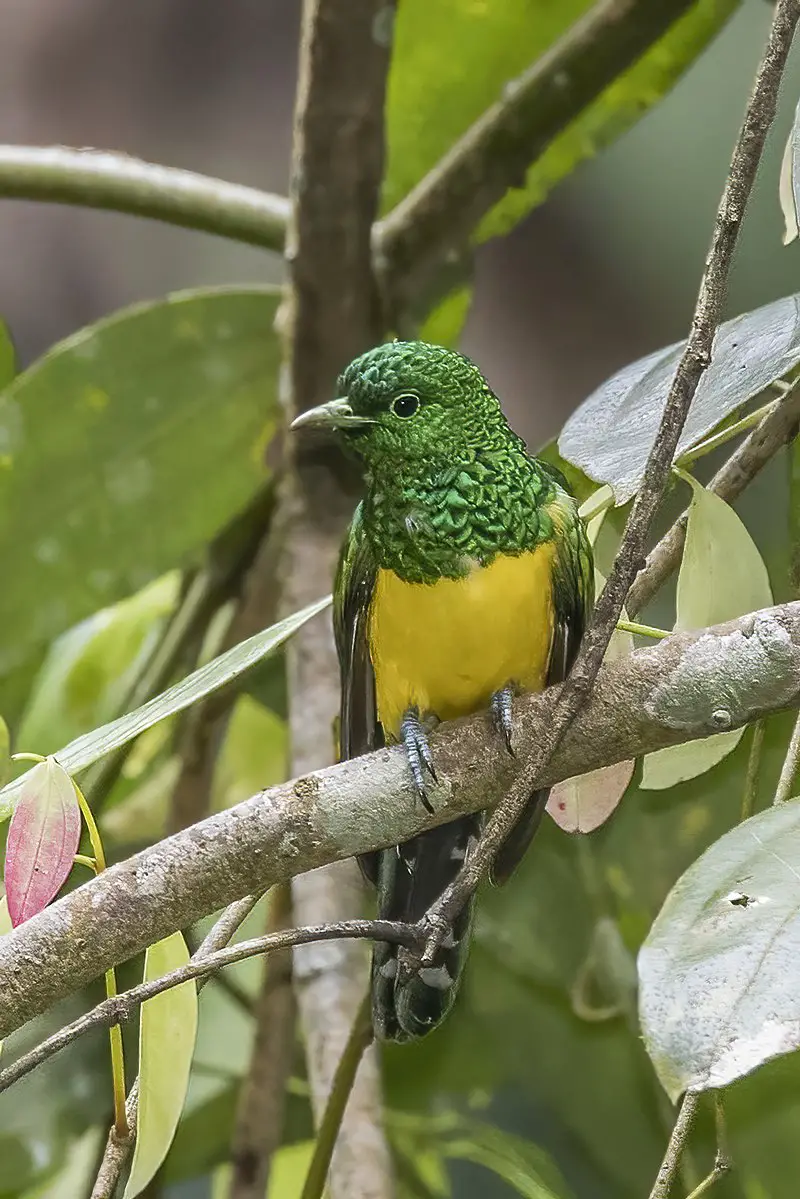
The African emerald cuckoo is a species of Old World cuckoo that can be found across much of sub-Saharan Africa.
It has four unique subspecies, C.c. cupreus, C.c sharpei, C.c intermedius and insularum which have adapted to their respective areas in the continent over time and are distinguishable by minor differences such as size or plumage colouration.
This bird feeds mainly on arthropods but will also consume fruit from trees like mangoes when available during its breeding season spanning from December to April depending upon location.
The female lays eggs directly into other birds’ nests without them knowing for it raise her own young with no effort required by her; this behavior gives the species its name ‘Cuckoo’ as it is thought to mimic the sound made by these birds within their habitat.Scientific classification:
| Kingdom | Animalia |
| Phylum | Chordata |
| Class | Aves |
| Order | Cuculiformes |
| Family | Cuculidae |
| Genus | Chrysococcyx |
| Species | C. cupreus |
33. Klaas’s Cuckoo
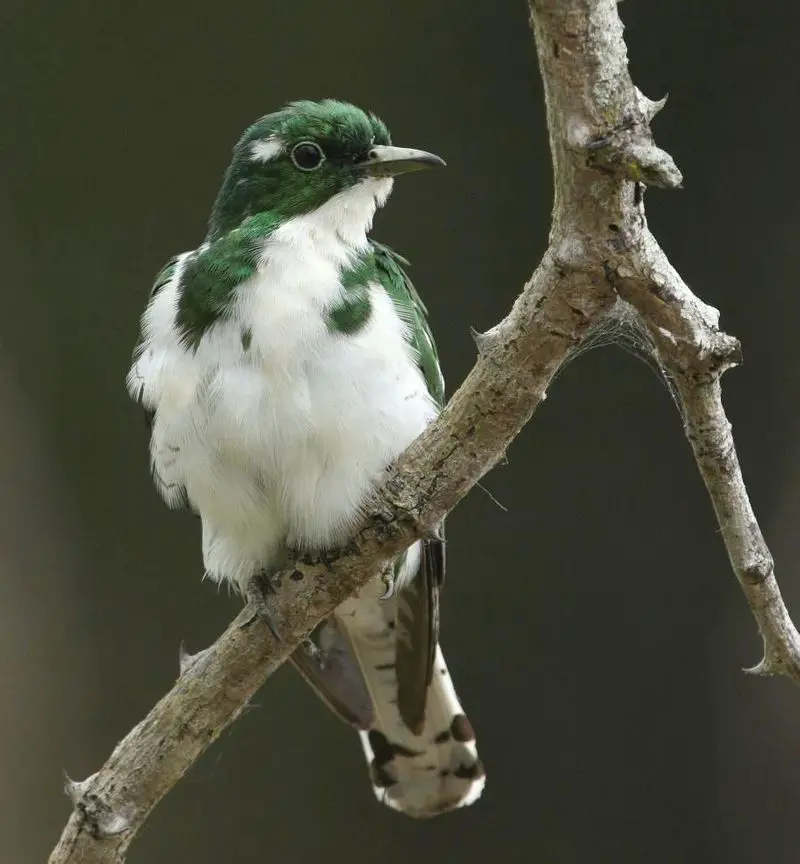
Klaas’s cuckoo is a species of bird found in the wooded areas of sub-Saharan Africa.
The unique species was named after Klaas, the Khoikhoi man who collected the first specimen and presented it to French explorer François Le Vaillant in 1806.
It belongs to the family Cuculidae which encompasses many cuckoos around the world including Old World cuckoos native to Eurasia and New World tropical cuckoos from Central and South America.
This small bird can be identified by its greyish back, white belly with dark streaks on either side, yellowish brown wings with black tips along tail feathers, red eyes, pale bill and blue legs.
Its diet consists mainly of insects such as caterpillars while they are also known for their parasitic behaviour where they lay eggs inside other birds’ nests instead of building their own nest or incubating them themselves.
All in all , Klaas’s cukcoo is an interesting yet enigmatic creature that has been studied for centuries but still holds much mystery about itself.Scientific classification:
| Kingdom | Animalia |
| Phylum | Chordata |
| Class | Aves |
| Order | Cuculiformes |
| Family | Cuculidae |
| Genus | Chrysococcyx |
| Species | C. klaas |
34. Black Cuckoo
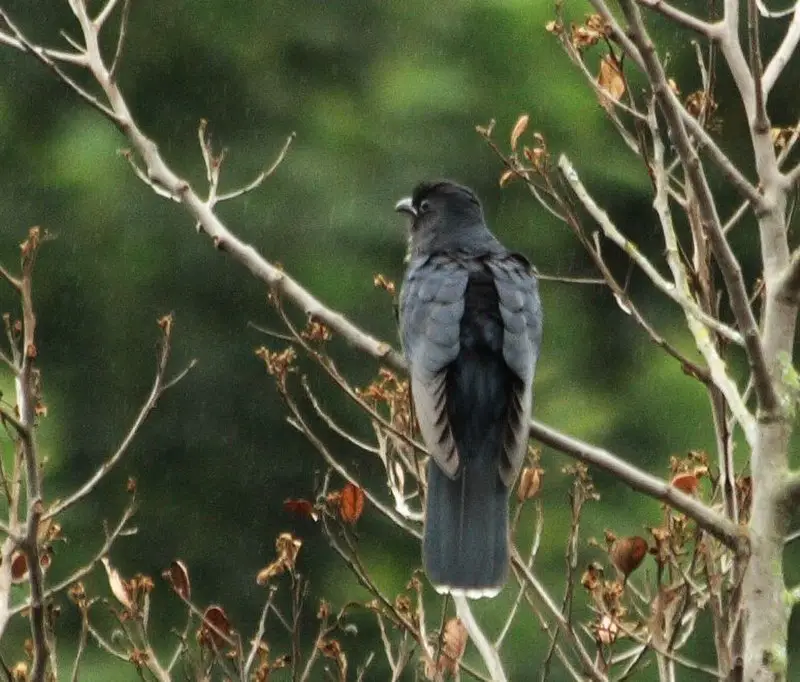
The Black Cuckoo is a species of cuckoo native to sub-Saharan Africa. It has two distinct subspecies and is classified as “Least Concern” by the International Union for Conservation of Nature due to its wide range and high population numbers.
This bird measures about 32 cm in length, with males slightly larger than females. Its plumage varies from black or grey on its upperparts, while it’s underparts are white or light grey in colour, sometimes flecked with darker markings.
The wings have dark outer feathers but barred inner ones; the tail is rounded and usually blackish brown above while being whitish underneath.
This cuckoo feeds mainly on insects such as beetles and caterpillars which it finds amongst foliage or along woodland edges, occasionally also taking berries when available.
A distinctive call can be heard throughout much of their distribution area during breeding season – consisting of a soft ‘coo’ followed by an upward trill that increases in pitch at the end.Scientific classification:
| Kingdom | Animalia |
| Phylum | Chordata |
| Class | Aves |
| Order | Cuculiformes |
| Family | Cuculidae |
| Genus | Cuculus |
| Species | C. clamosus |
35. Pel’s Fishing Owl
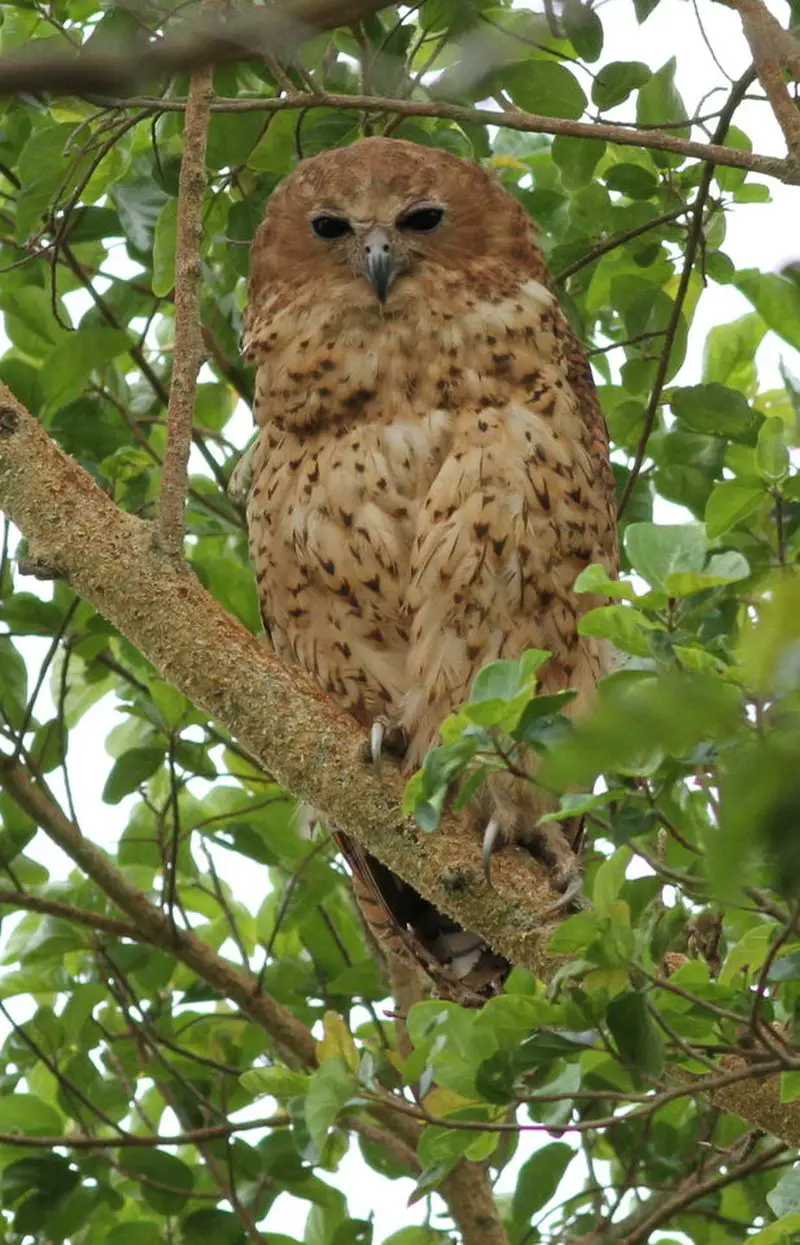
Pel’s fishing owl is a large species of Strigidae found in Africa. It hunts mainly at night, snatching up fish and frogs from rivers and lakes with its sharp talons.
They prefer slow-moving waterways with lots of overhanging trees so they can roost during the day or hunt for prey without being seen.
The owls nest in hollows or forks of large trees to stay safe from predators.
Even though there are many threats that put these birds at risk, conservation efforts have helped secure their population numbers for now.Scientific classification:
| Kingdom | Animalia |
| Phylum | Chordata |
| Class | Aves |
| Order | Strigiformes |
| Family | Strigidae |
| Genus | Scotopelia |
| Species | S. peli |
36. Green-Backed Honeybird
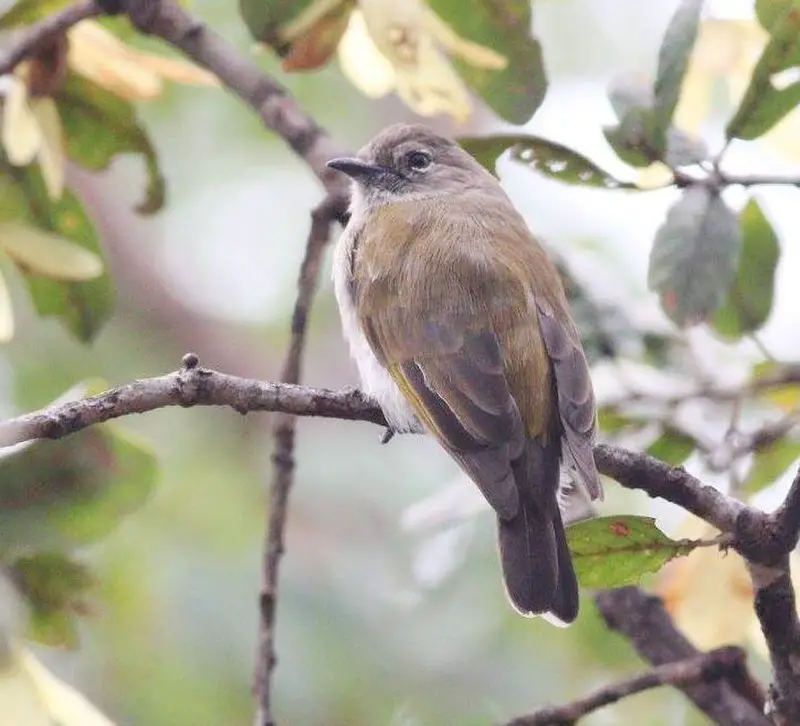
The Green-backed honeybird is a species of bird from the Indicatoridae family. It lives in southern Africa, including Angola, Botswana, Democratic Republic of the Congo and Zimbabwe.
Its name comes from its green back feathers which it uses to identify itself with other birds. This small sized bird has a slender bill used for finding nectar and insects on trees or shrubs.
When they find food sources like bees nests or termite mounds they use their call to attract predators such as humans who can help them access these otherwise hard-to-reach places by breaking open the nest or mound walls.
The Green-backed Honeybird plays an important role in helping local communities sustain their diet due to this behavior.Scientific classification:
| Kingdom | Animalia |
| Phylum | Chordata |
| Class | Aves |
| Order | Piciformes |
| Family | Indicatoridae |
| Genus | Prodotiscus |
| Species | P. zambesiae |
37. Verreaux’s Eagle-Owl
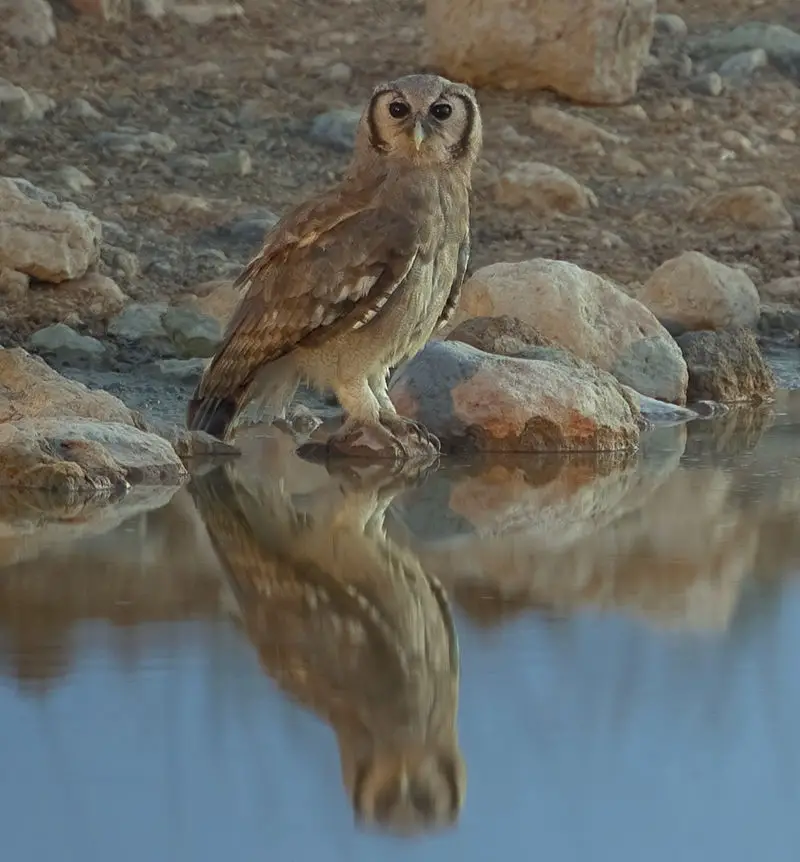
Verreaux’s eagle-owl is a magnificent bird that can be found in dry, wooded savannas of sub-Saharan Africa. It is the largest African owl and measures up to 66 cm (26 inches) long.
This majestic creature has grey plumage with white spots on its back and wings, while its face is covered by an impressive facial disk.
Its eyes are yellowish orange in color, surrounded by white feathers which give it a striking appearance.
These birds hunt mostly during the night but may occasionally also do so during daylight hours when food becomes scarce or if they have recently hatched young ones who need feeding.
Verreaux’s eagle-owls live alone or in pairs for much of the year until breeding season comes around after which two eggs will be laid at once and incubated for about 30 days before hatching into fluffy chicks.Scientific classification:
| Kingdom | Animalia |
| Phylum | Chordata |
| Class | Aves |
| Order | Strigiformes |
| Family | Strigidae |
| Genus | Bubo |
| Species | B. lacteus |
38. Sociable Weaver
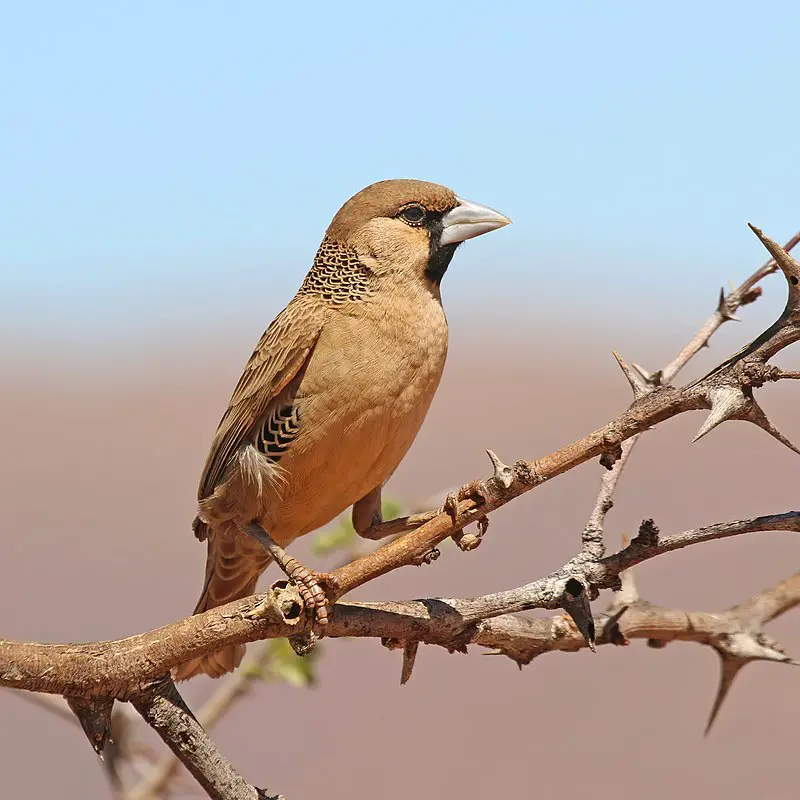
The Sociable Weaver is a species of bird found in southern Africa, mainly South Africa, Namibia and Botswana. It is the only member of its monotypic genus Philetairus.
These birds are known for their large compound community nests which makes them quite unique among other birds.
This type of nesting behavior has enabled them to survive in hot environments since the collective body heat from multiple individuals helps keep the nest cooler than outside temperatures during summer months.
They feed on insects and plants which they find close to or within their colonies due to lack of migratory instincts like most small passerines do during winter seasons when food sources become scarce near settlements.Scientific classification:
| Kingdom | Animalia |
| Phylum | Chordata |
| Class | Aves |
| Order | Passeriformes |
| Family | Ploceidae |
| Genus | Philetairus A. Smith, 1837 |
| Species | P. socius |
39. Pale Chanting Goshawk
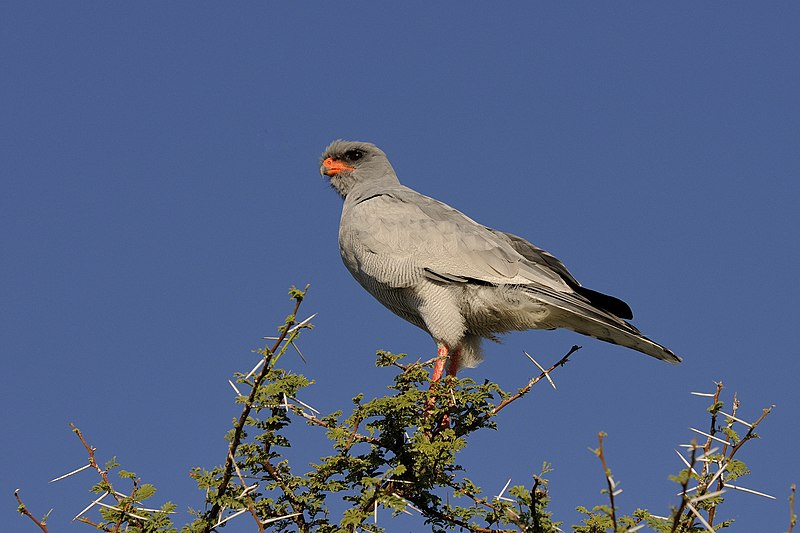
The Pale Chanting Goshawk is a bird of prey found in southern Africa. It typically resides in dry, semi-desert areas with an annual rainfall of 75cm or less.
At 55 cm long and with a wingspan of 110 cm, it is easily spotted perched on telephone poles due to its grey upperparts and white rump.
Its diet consists mainly of small mammals such as rodents but can also include reptiles, birds and insects.
The female lays 2-3 eggs which are incubated by both parents for around 4 weeks before hatching into chicks that will fledge the nest after five weeks or so.
This species plays an important role in controlling populations of small animals like mice and rats while providing great opportunities for bird watchers to observe them during their breeding season from October through December each year.Scientific classification:
| Kingdom | Animalia |
| Phylum | Chordata |
| Class | Aves |
| Order | Accipitriformes |
| Family | Accipitridae |
| Genus | Melierax |
| Species | M. canorus |
40. Sandgrouse
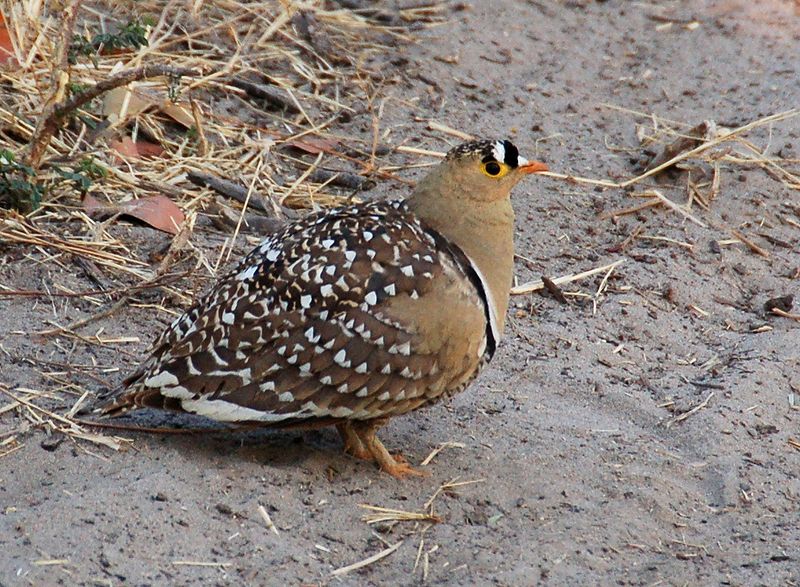
Sandgrouse is birds of the order Pterocliformes, found mainly in Africa and Asia. There are sixteen species belonging to two genera – Syrrhaptes from central Asia and Pterocles from Africa and other Asian countries.
They inhabit treeless areas such as deserts, steppes, scrubland, or savannas and tend to be ground-dwelling birds that feed on seeds.
Sandgrouse has adapted special features for survival in their harsh environment.
They possess well-developed feet with four toes used for walking over hot sand while keeping their body temperature cool at all times by regulating heat loss through their legs.
Their feathers also act like a sponge helping them absorb water before flying long distances back home where they then expel it using specialized glandular secretions located near the wings so that chicks can drink directly from an adult’s breast plumage.Scientific classification:
| Kingdom | Animalia |
| Phylum | Chordata |
| Class | Aves |
| Clade | Columbimorphae |
| Order | Pterocliformes Huxley, 1868 |
| Family | Pteroclidae Bonaparte, 1831 |
41. Threskiornithidae
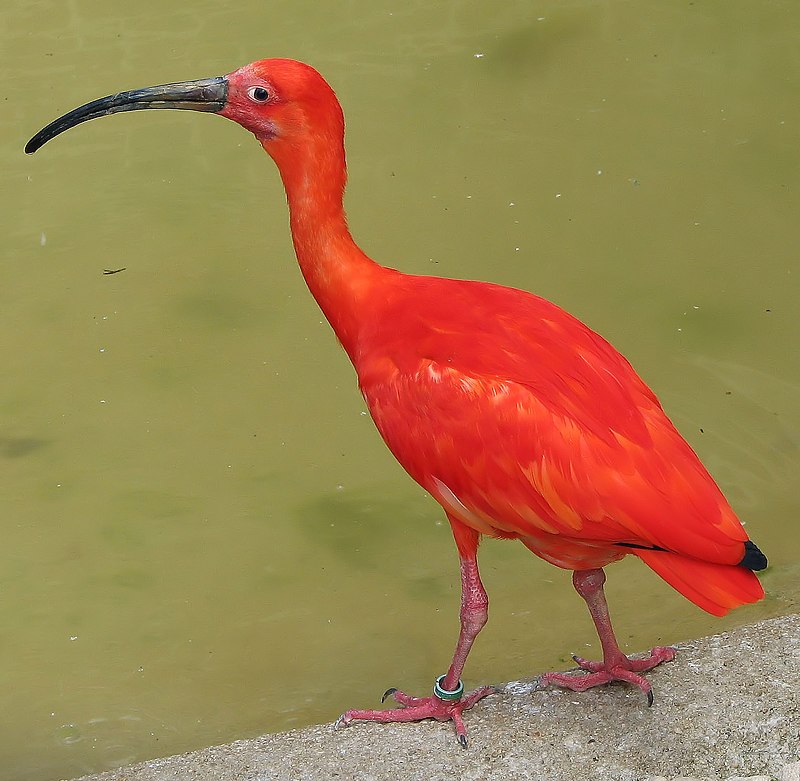
Threskiornithidae is a family of large wading birds which includes 36 species. These birds are traditionally divided into two subfamilies – the ibises and the spoonbills.
However, recent genetic analysis has shown that spoonbills actually belong to Old World ibis group, while New World ibises form an early offshoot from this lineage.
Threskiornithidse members have long curved beaks with serrated edges used for catching fish in shallow water or mudflats, as well as other aquatic invertebrates like crustaceans and mollusks.
They also feed on plant matter such as grains and seeds found close to wetlands areas where they live.
This diverse diet makes them important scavengers in their ecosystems, helping maintain healthy populations of native wildlife by controlling insect numbers and dispersing energy-rich seeds throughout wetland habitats.Scientific classification:
| Kingdom | Animalia |
| Phylum | Chordata |
| Class | Aves |
| Order | Pelecaniformes |
| Suborder | Ardei |
| Family | Threskiornithidae Richmond, 1917 |
42. Southern Masked Weaver
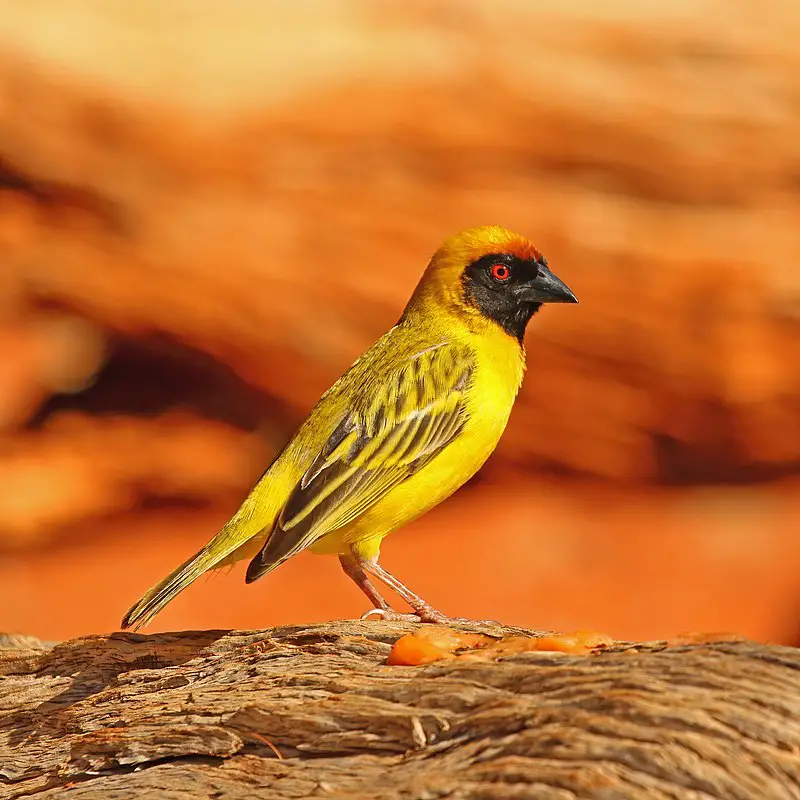
The Southern masked weaver is an incredibly widespread bird species commonly found throughout southern Africa.
It inhabits a variety of different habitats, from shrubs and savannas to open woodlands, wetlands and even semi-deserts areas.
This vibrant bird measures between 11–14.5 cm in length and can be spotted in suburban gardens searching for food or building its famously intricate nests using grass strips.
Its diet consists mainly of seeds supplemented by insects during the breeding season when they need more protein to feed their young ones.
They build communal nesting colonies that are composed of several hanging basket-shaped woven nests made out of dried grasses which hang from trees or reed beds near water bodies – making it easy for them to find food as well as providing protection against predators such as snakes.Scientific classification:
| Kingdom | Animalia |
| Phylum | Chordata |
| Class | Aves |
| Order | Passeriformes |
| Family | Ploceidae |
| Genus | Ploceus |
| Species | P. velatus |
Also Featured In: Savanna Birds You Need to See, Birds You’ll Find in Kenya Safari
43. Gruiformes
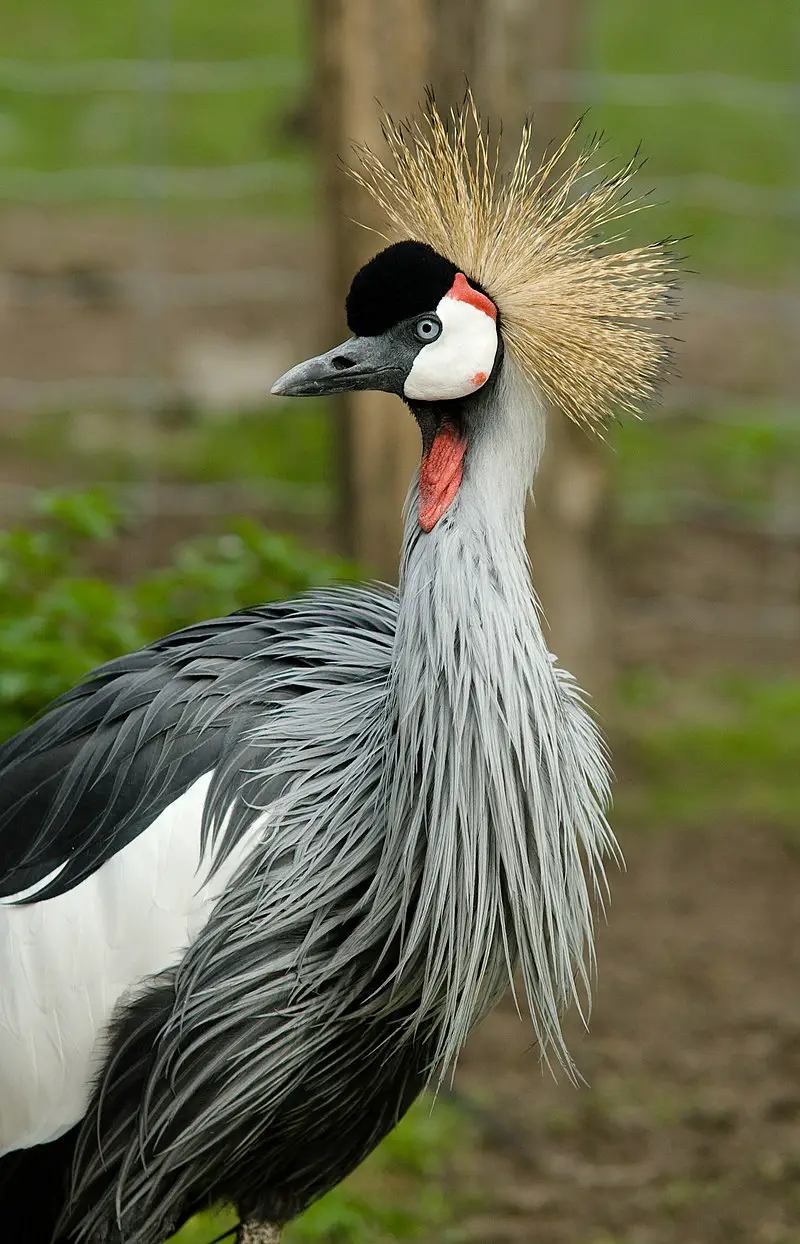
The Gruiformes is an order of birds which contains a large variety of families, both living and extinct. They are found all over the world in many different habitats, including wetlands and grasslands.
The name comes from Latin for “crane-like” due to their similar appearance to cranes. Many members of this group have long legs adapted for wading or running on land depending on species.
They also typically have long beaks used for hunting prey such as insects and small animals like fish, frogs and lizards.
Other traits commonly shared by these birds include strong wings with broad flight feathers that help them soar through the air when migrating or searching food sources during winter months.
In addition to these physical characteristics, some Gruiformes also possess vocalizations unique among other bird orders – making them easily recognizable even at great distances.Scientific classification:
| Kingdom | Animalia |
| Phylum | Chordata |
| Class | Aves |
| Clade | Gruimorphae |
| Order | Gruiformes Bonaparte, 1854 |
44. Red-Crested Korhaan
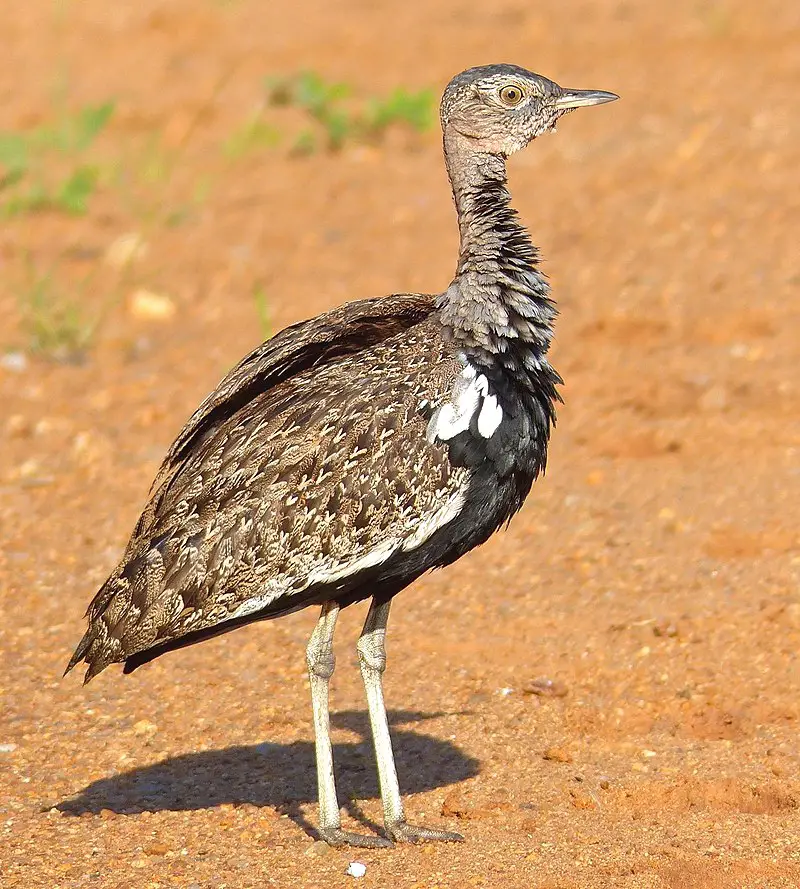
The Red-crested Korhaan is a species of bird that can be found in Angola, Botswana, Mozambique, Namibia South Africa, Swaziland Zambia and Zimbabwe. It has stunning red crest on its head giving it an attractive look.
This beautiful bird grows up to 50 cm long with the weight reaching 680 gm maximum. The wings have V shaped feathering pattern when folded on back which further adds to their beauty.
These birds are known for their loud call which they use while courtship or during territorial disputes among adults males of same kind.
They mainly feed on insects but also consume fruits and vegetable matter occasionally as well depending upon what’s available nearby themScientific classification:
| Kingdom | Animalia |
| Phylum | Chordata |
| Class | Aves |
| Order | Otidiformes |
| Family | Otididae |
| Genus | Lophotis |
| Species | L. ruficrista |
45. Crowned Lapwing
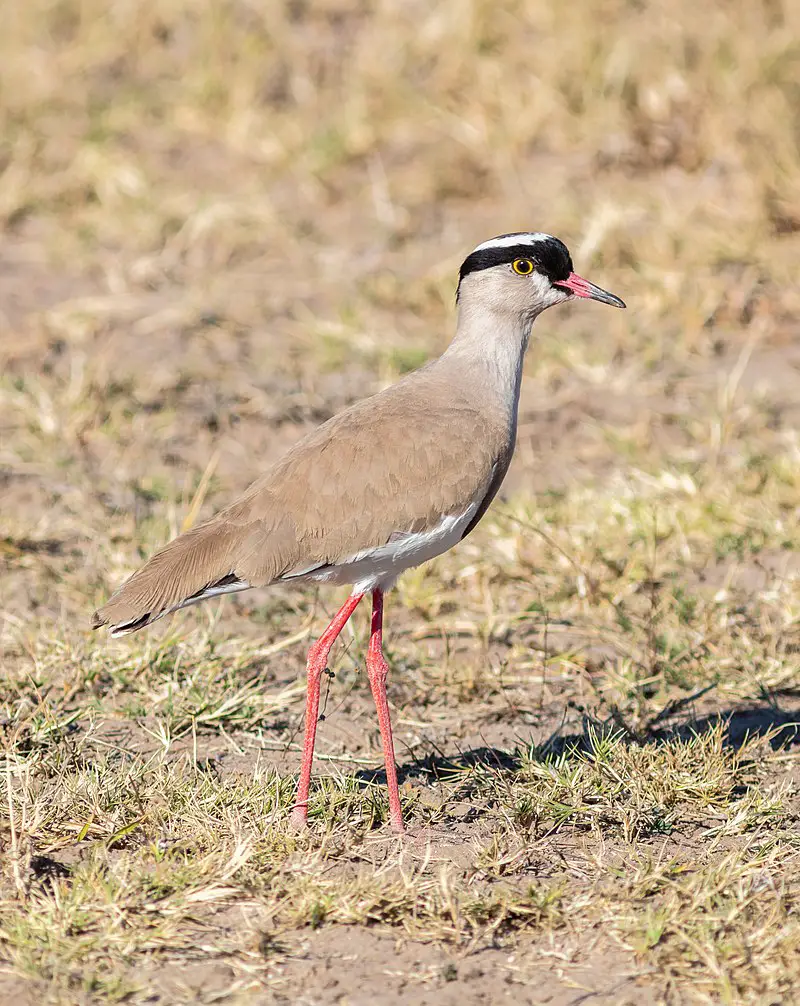
The crowned lapwing is a striking bird of the subfamily Vanellinae, found in many parts of Africa. Their most distinctive feature is their bright and attractive crown-shaped crest on the head.
They typically have brown plumage with white spots over the wings and tail, as well as yellow legs and beaks.
These birds are known for being quite vocal; they make loud calls to communicate between one another or warn predators away from their nests.
Crowned lapwings can live up to 10 years in captivity but usually only survive 1–2 years in the wild due to predation by other animals such as cats, dogs, snakes and hawks.
Despite this mortality rate these birds remain common throughout much of Africa thanks to their adaptability and ability nest near humans without conflict.Scientific classification:
| Kingdom | Animalia |
| Phylum | Chordata |
| Class | Aves |
| Order | Charadriiformes |
| Family | Charadriidae |
| Genus | Vanellus |
| Species | V. coronatus |
46. Southern Yellow-Billed Hornbill
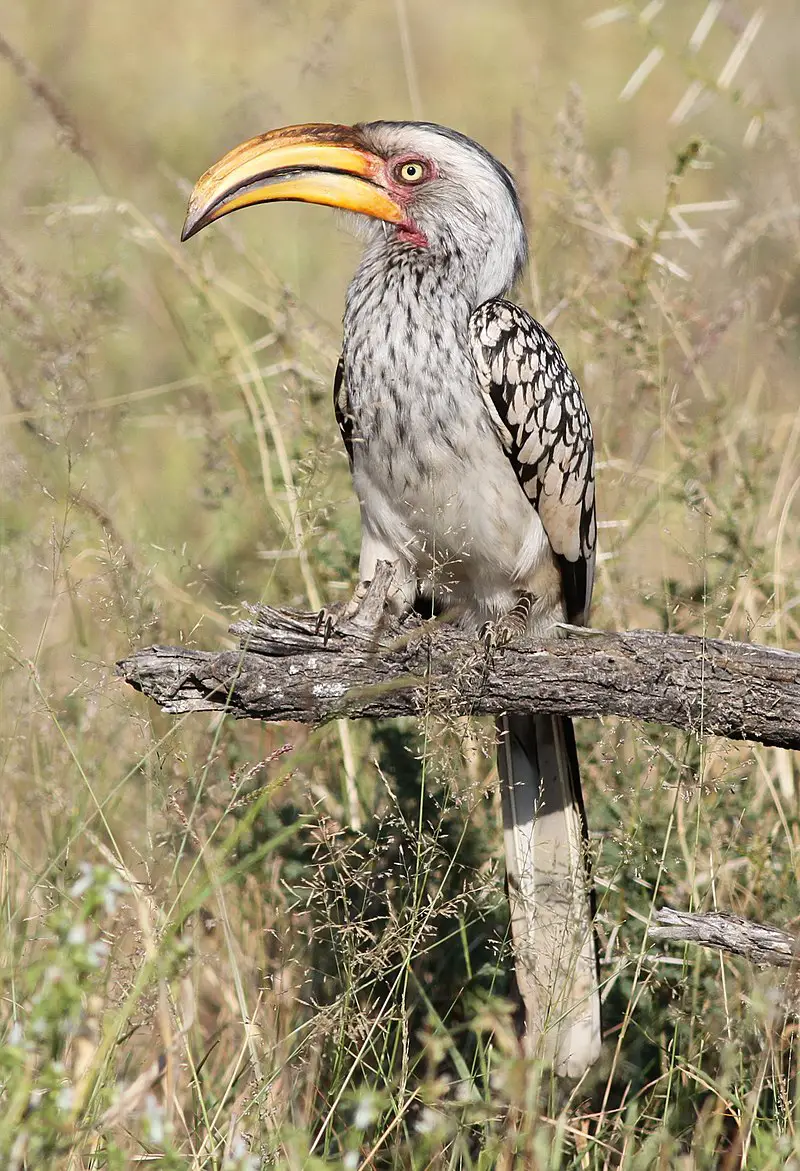
The Southern yellow-billed hornbill is a species of medium sized bird found in southern Africa. It feeds mainly on the ground, foraging for seeds, insects, spiders and scorpions.
These birds are quite common and can be seen along roadsides and water courses due to their preference of dry thornveldt as well as broad-leafed woodlands.
They have bright yellow bills which make them easily recognizable among other birds.
The average length of these beautiful creatures range between 40 – 48 cm with an impressive wingspan reaching up to 90 cm wide.
This stunning species is considered vulnerable by IUCN since it’s numbers are slowly declining due to hunting activities and habitat destruction from urbanization.Scientific classification:
| Kingdom | Animalia |
| Phylum | Chordata |
| Class | Aves |
| Order | Bucerotiformes |
| Family | Bucerotidae |
| Genus | Tockus |
| Species | T. leucomelas |
47. Burchell’s Sandgrouse
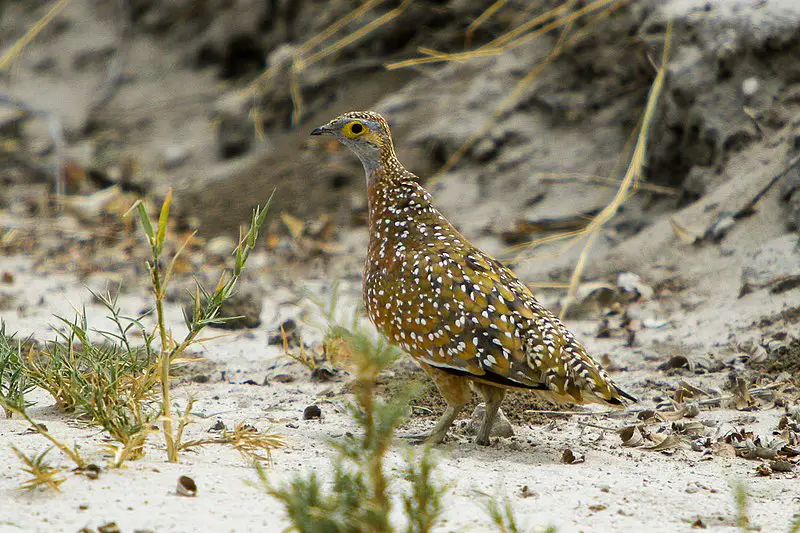
Burchell’s sandgrouse is a species of bird native to southern Africa. It has a plump body about the size of a pigeon, with light brown plumage mottled in darker shades and white.
Its small head sits atop short legs, making it an instantly recognisable species.
The name Burchell’s sandgrouse was bestowed by English naturalist William John Burchell in commemoration of his work studying avian life across the world.
This remarkable creature can be found living in arid and semi-arid regions throughout its range, adapting well to survive even under harsh conditions.
In conclusion, this unique little bird deserves much admiration for its resilience and beauty alike.Scientific classification:
| Kingdom | Animalia |
| Phylum | Chordata |
| Class | Aves |
| Order | Pterocliformes |
| Family | Pteroclidae |
| Genus | Pterocles |
| Species | P. burchelli |
48. Namaqua Sandgrouse
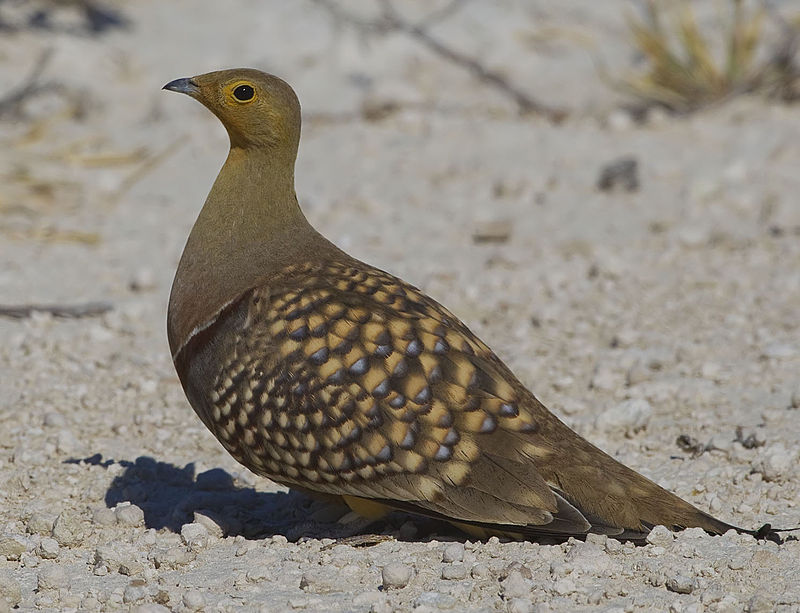
The Namaqua sandgrouse is a species of ground-dwelling bird belonging to the sandgrouse family.
It inhabits arid regions in south-western Africa and was formally described by German naturalist Johann Friedrich Gmelin in 1789 as part of his revised edition of Carl Linnaeus’ Systema Naturae.
Featuring a mottled buff, grey and brown plumage, it has black markings on its wings that help distinguish it from other birds within its range.
The male also displays an eye comb, which consists of two rows of upright feathers forming lengthy tufts around the eyes.
They feed mainly on seeds but will supplement their diet with insects if available during times when food is scarce.
During breeding season they form monogamous pairs who share incubation duties for up to four eggs per clutch before raising them together until they are ready to fledge at approximately 30 days old.Scientific classification:
| Kingdom | Animalia |
| Phylum | Chordata |
| Class | Aves |
| Order | Pterocliformes |
| Family | Pteroclidae |
| Genus | Pterocles |
| Species | P. namaqua |
49. White-Fronted Bee-Eater
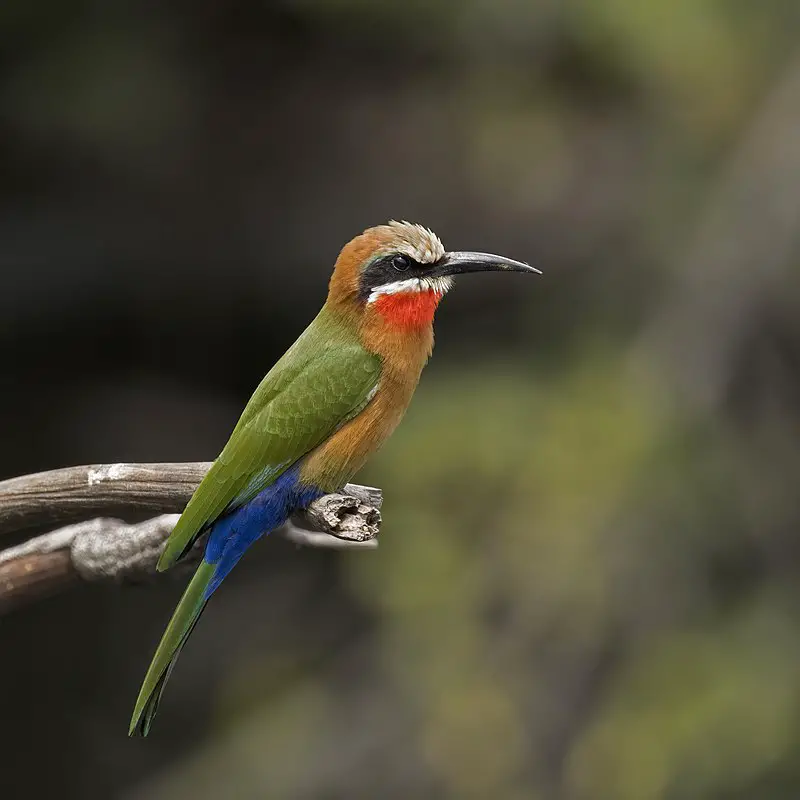
The White-fronted Bee-eater is a beautiful bird native to subequatorial Africa. It has an unmistakable white forehead, square tail and bright red throat patch that sets it apart from other species of bee eaters.
These birds typically nest in colonies by digging holes into cliffs or earthen banks near waterbodies.
During the day they can be seen perched on low trees waiting for passing insects which they swoop down upon with great agility to capture their prey midair.
They may also hover around flowers while searching for food – making them quite a sight to behold indeed.
All in all, these majestic creatures are truly fascinating to observe and make wonderful additions to any natural habitat.Scientific classification:
| Kingdom | Animalia |
| Phylum | Chordata |
| Class | Aves |
| Order | Coraciiformes |
| Family | Meropidae |
| Genus | Merops |
| Species | M. bullockoides |
50. Hartlaub’s Gull
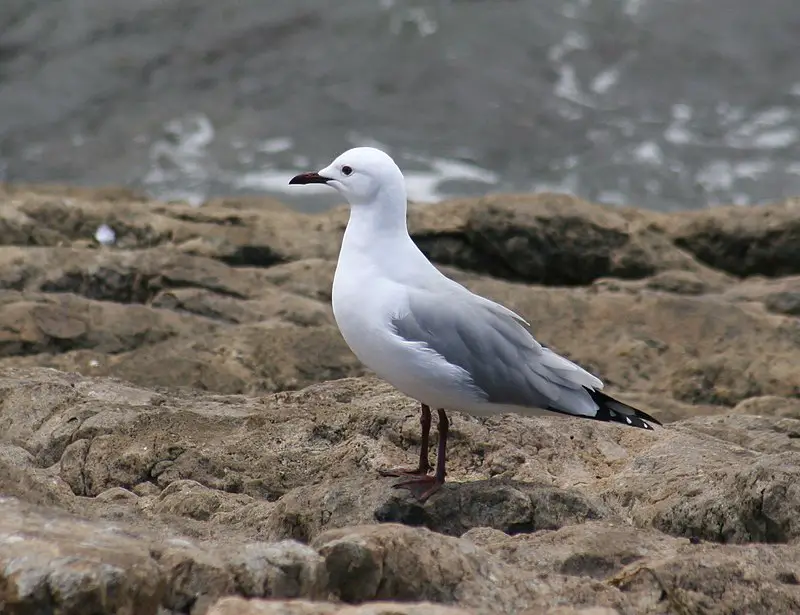
Hartlaub’s gull, also known as the king gull, is a small species of seagull found in parts of Africa and Asia. It was once thought to be subspecies of silver gull but has since been placed within its own genus Chroicocephalus.
The bird was named after German zoologist and physician Gustav Hartlaub who first described it in 1857.
This species usually have grey-brown upperparts with a yellow bill that appears black at times due to the amount darkness on their plumage.
They mainly feed on fish, crustaceans and insects which they hunt from rocky shores or mudflats near coasts or estuaries.
These birds often form flocks when foraging for food making them highly visible by shoreline visitors especially during summer months when they breed along coastal areas throughout their range annually laying 2–3 eggs at each nest site built atop cliffs or ledges either alone or amongst other nesting sea birds such as cormorants and terns.Scientific classification:
| Kingdom | Animalia |
| Phylum | Chordata |
| Class | Aves |
| Order | Charadriiformes |
| Family | Laridae |
| Genus | Chroicocephalus |
| Species | C. hartlaubii |